There are many types of white butterflies native to the US. These bright butterflies are found in all regions of the country, particularly in the West and the South.
White butterflies in the US have a wingspan between 29 and 96mm and they can have different patterns and color variations even within the same species, particularly between males and females.
These butterflies live in all types of terrains and altitudes. From canyons to elevations of up to a few thousand feet, white butterflies of the Us are also seen in different types of habitats.
These butterflies live in woodlands, next to woodlands, savannahs, and deserts.
They adapt to mainly feeding on plant nectar with a wide preference towards wild buckwheat, thistles, and other sources of nectar.
Host plants typically differ for caterpillars of white butterflies. Buckwheat tends to be favored by many species of butterflies for laying eggs and their larvae while adults move along to eat nectar from other species.
Some white butterflies in the US are also migratory. They move territories looking for food, to escape predation, or to seek more pleasant temperatures.
Such butterflies can be seen in multiple zones of the country for a limited time before they migrate.
The following species of white butterflies are native or established in the US.
Table of Contents
1. Cabbage White
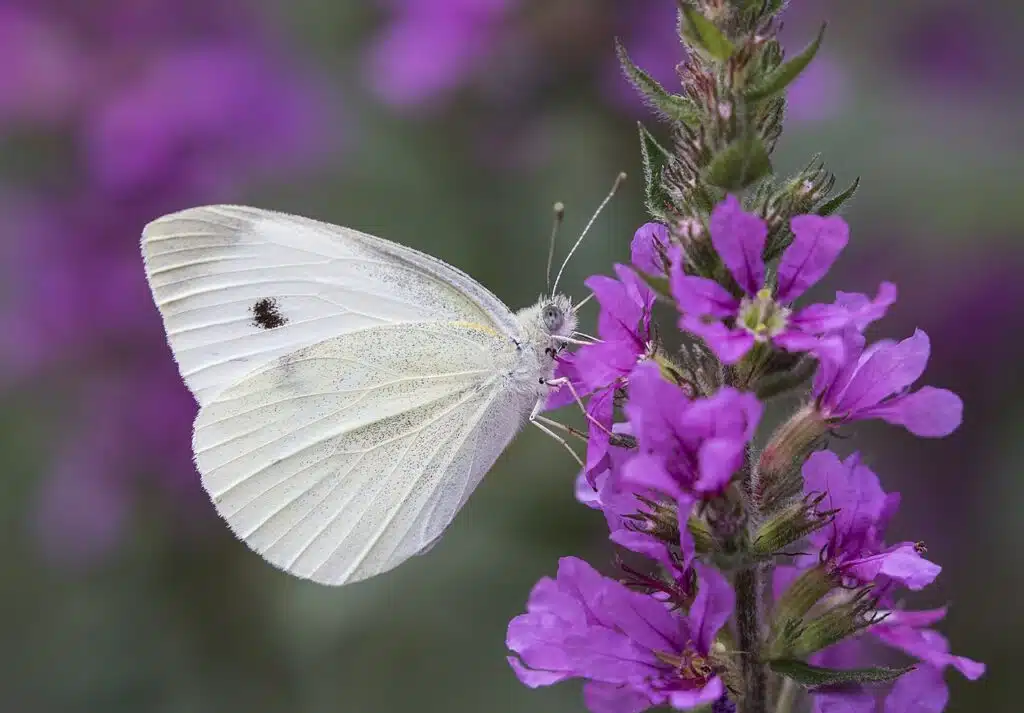
Cabbage Whites (Pieris rapae) are some of the most common white butterflies in the United States and Even around the world.
This species established itself in Europe in Canada first. It then spread across the US.
It’s believed a single female can breed colonies of millions of Cabbage Whites when eggs are laid in high numbers over the timeline of a few years.
This species has mostly white coloring which appears off-white in the case of the females as males have brighter coloring.
Dark gray or dark brown spots are seen on the hindwings of the species.
Nappa cabbage often provides the much-needed nectar for feeding the Cabbage White.
2. Eastern Tailed-Blue
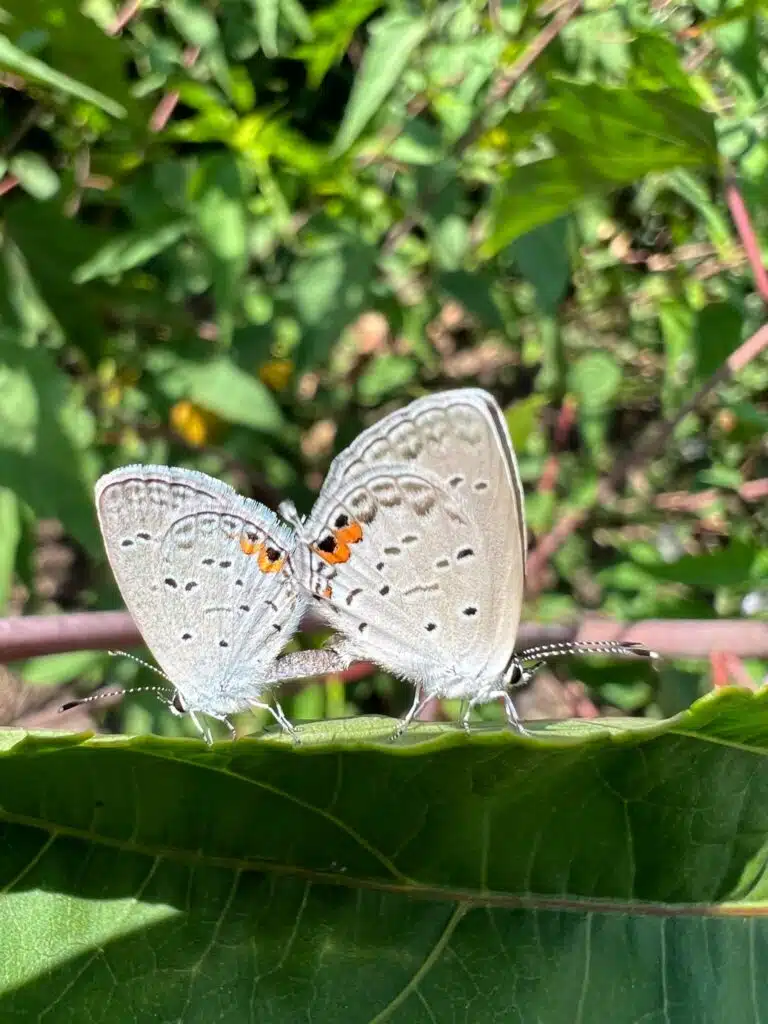
This species (Cupido comyntas) comes in different colors that range from blue to light blue, or white.
All of the colors the butterfly come in are associated with small black dots around the wings as well.
Very common across the United States and especially in the Eastern states, this species of butterfly is known for flying low.
It’s always seen close to the ground and finding an Eastern Tailed-Blue is sometimes subject to finding its preferred flowers.
These are small flowers such as clovers and shepherd’s needle. Like other butterflies, the Eastern Tailed-Blue also consumes the nectar of wild strawberries.
3. Checkered White
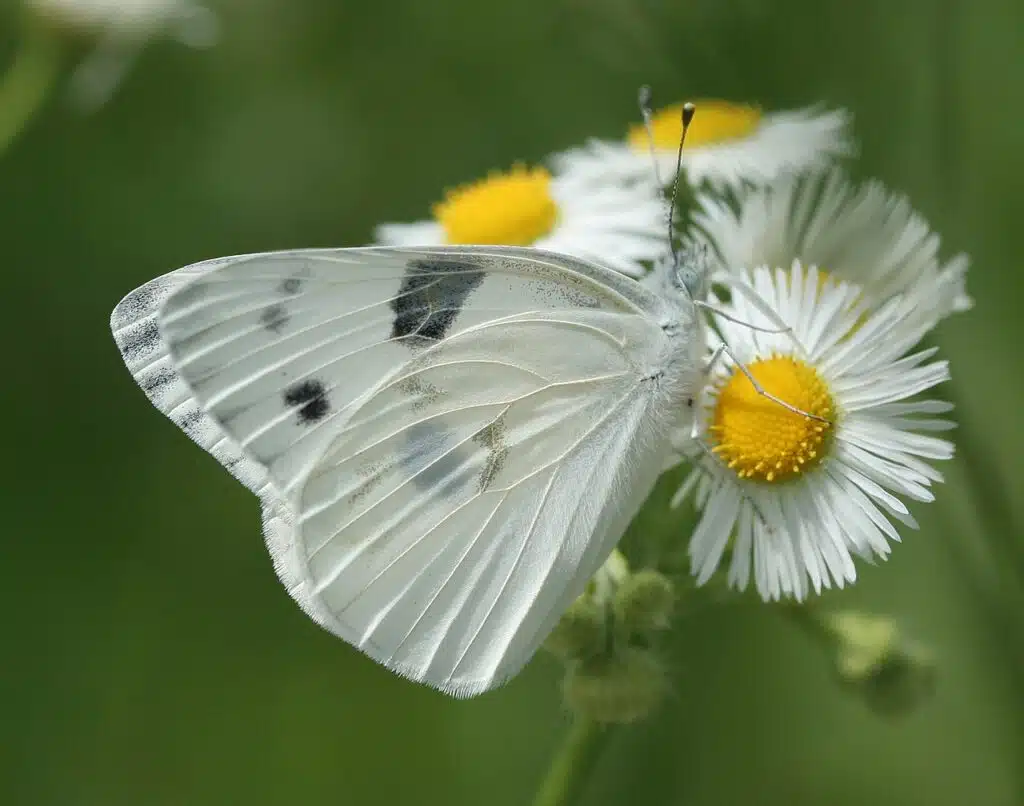
Checkered White butterflies (Pontia protodice) are a white species native to the US and Canada. The presence of Checkered Whites is widespread in almost all states.
As with many white butterflies, there are certain differences between males and females in terms of shade.
The white male is known for having a bright nuance compared to the off-white female.
Marks on the wings are also slightly distinct from males to females. Male Checkered Whites have gray marks while females have wider brown marks.
Some farmers know the Checkered White caterpillar as it’s a known cabbage worm.
Adults later feed on alfalfa and other crops.
4. Summer Azure
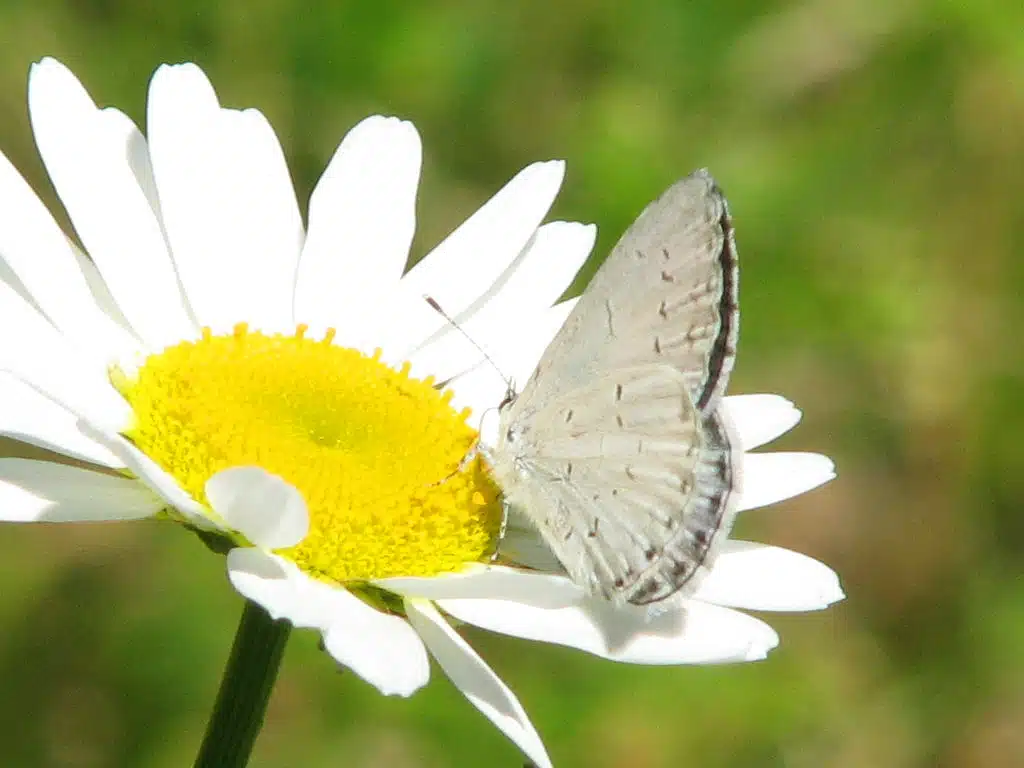
The Summer Azure (Celastrina neglecta) is a common species in Eastern US states.
Azures are sometimes blue and this is also the case with the Summer Azure. However, this species is also white.
Some females of the species are known for having white-dominant wings. They only show blue on the margins of the wings, unlike males which are mostly blue and only marginally white.
The male can also have blue coloring with black wing margins, a color combination that’s often common in many areas of the country.
This butterfly has a wingspan of up to 29mm and it’s also a native of Canada apart from being a US native.
5. Echo Azure
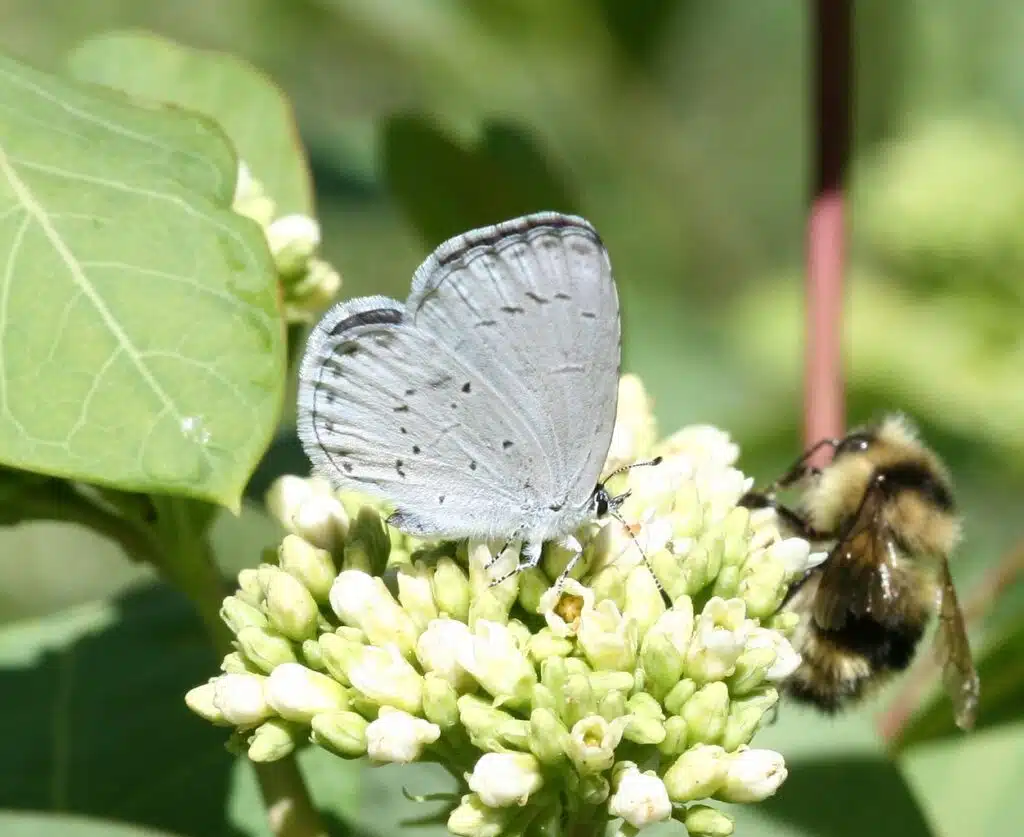
Echo Azures (Celastrina echo) have a light gray color that can sometimes be an off-white color depending on their region.
These butterflies are a common sight across multiple Eastern states which makes them instantly recognizable.
Females tend to have more white coloring than males.
Seen in states between Montana and California, Echo Azures are very specific on their host plants as caterpillars and the adult plants they feed on, unlike many other species.
Caterpillars feed on wild lilacs while adults also feed on wild lilacs and toyon.
Almost all woodlands in their habitat can provide the right conditions for the flowers these butterflies consume to grow.
6. Sara Orangetip
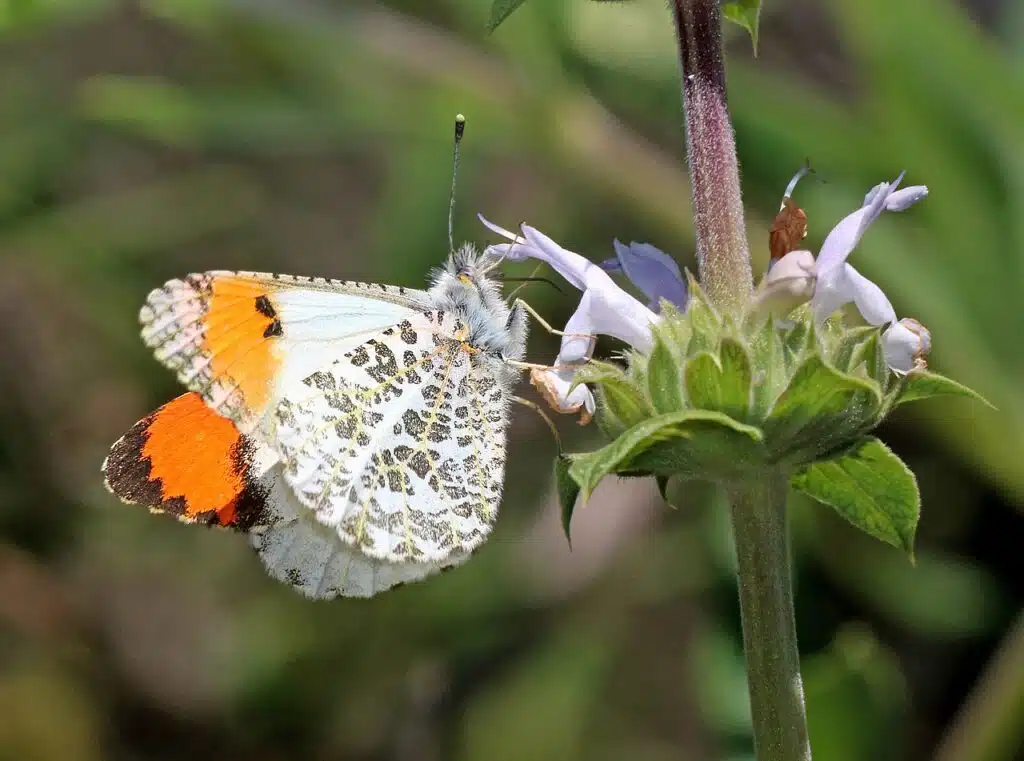
Sara Orangetip butterflies (Anthocharis sara) have white wings with orange wing tips.
This species grows to a wingspan of just over 1 inch and it has black separating bands between the orange and the white sections.
Sara Orangetip butterflies can be found across the Western states of the US.
They initially appear in mustard plants as females lay eggs on mustard leaves.
Adults of the species then move on to other plants for nectar and this includes thistles.
You can find Orangetip butterflies in woodlands and gardens.
7. Margined White
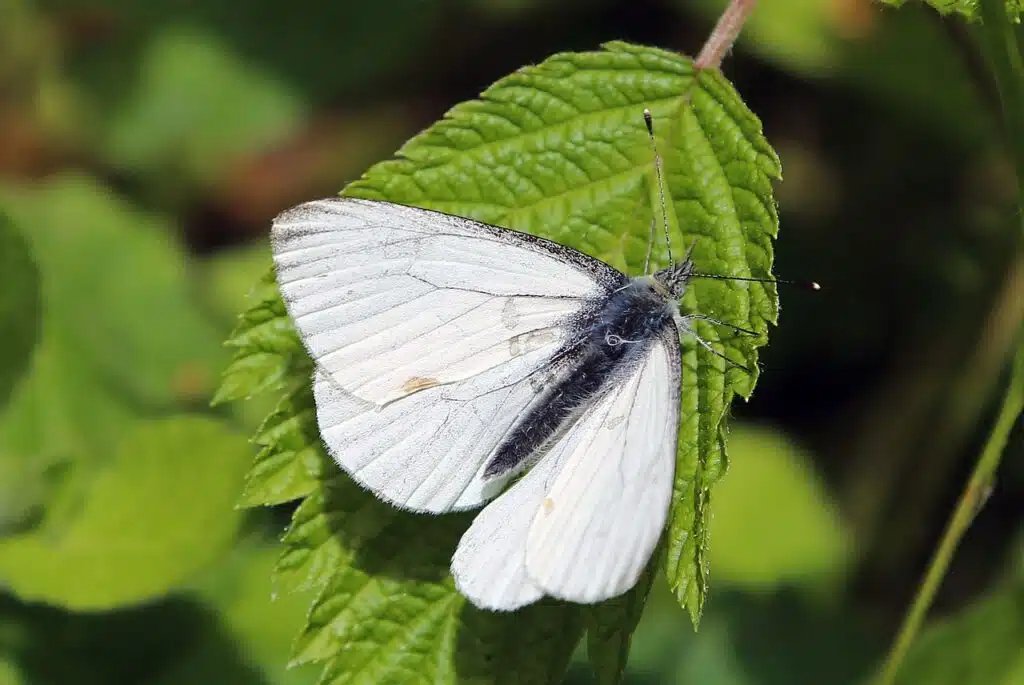
Margined Whites (Pieris marginalis) are seen in multiple US states. The species has white wings with dark gray or black vein-like bands.
Multiple habitats are among the places where the Margined White can be found. This includes woodlands and other open spaces such as prairies but also abandoned land.
Butterflies of this species are also seen on mustards as caterpillars, similar to Sara Orantips.
These butterflies also consume mustard nectar as adults.
8. Falcate Orangetip
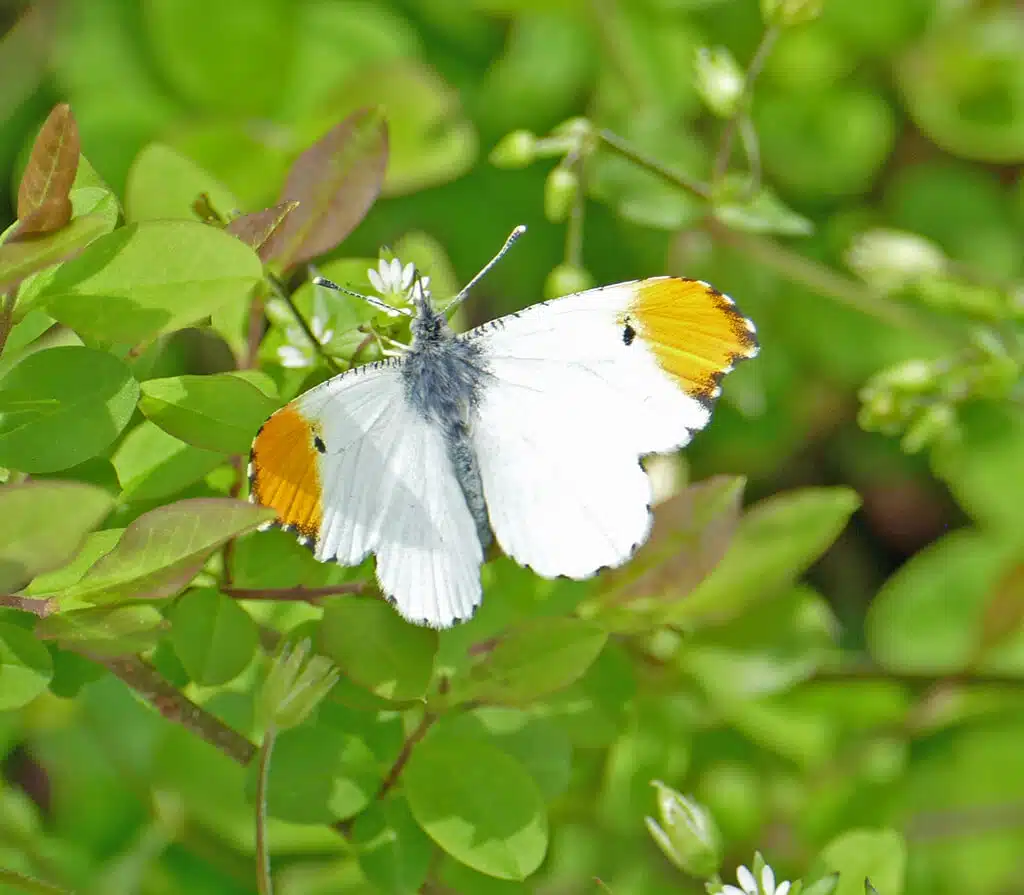
Flacate Orangetip (Anthocharis midea) is part of a wider group of orange tip butterflies native to the US.
However, they have sufficient distinct traits so they are easily identified.
Both males and females have a white body with white wings. But it’s only the male that has orange wing tips.
Females have an all-white body but they have intricate off-white patterns on the hindwings which resemble the reflection of marble.
The same patterns are also seen on the male Falcate Orangetips.
While the species can be seen in woodlands or around woodlands, it also prefers many open habitats across the US.
Adult Falcate Orantips are frequently seen consuming the nectar of mustard and violet flowers.
9. Lyside Sulphur
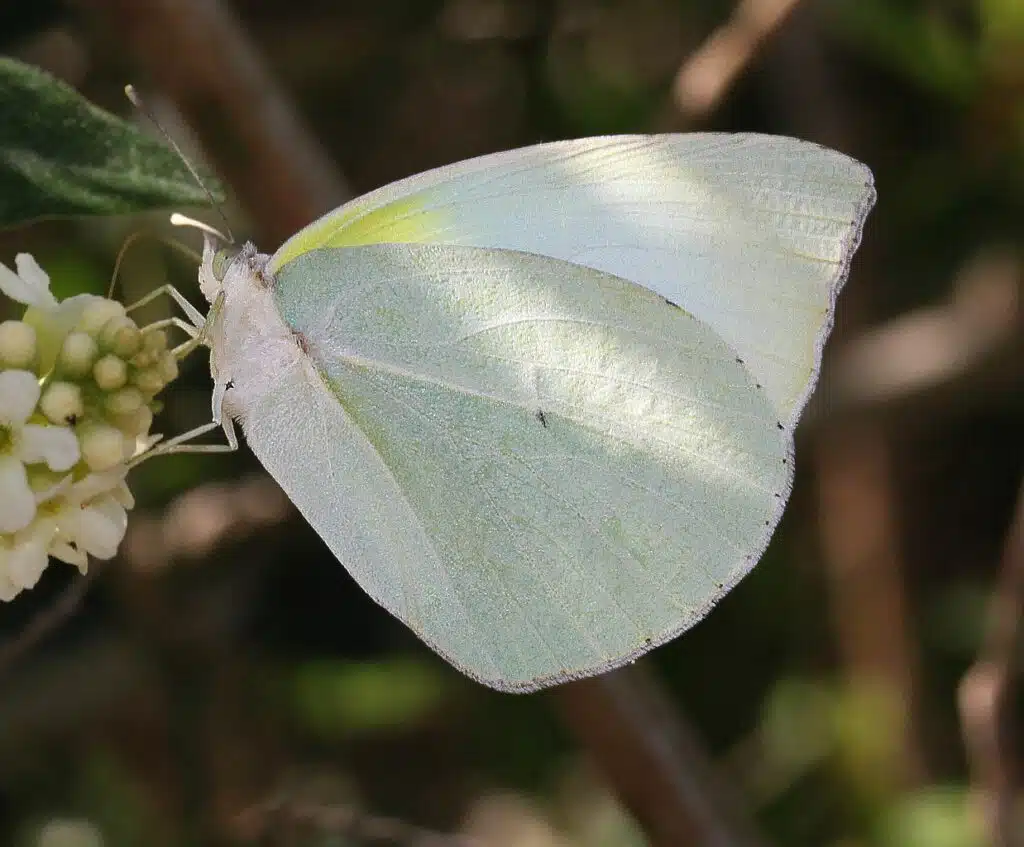
Lyside Sulphurs (Kricogonia lyside) have light green, light yellow, or even white coloring.
Markings on these butterflies also vary considerably depending on the state and their region within the state.
Lyside Sulphurs are seen in a white form in states such as Arizona, Texas, and Florida.
These butterflies remain active late into the fall.
10. Common Mestra
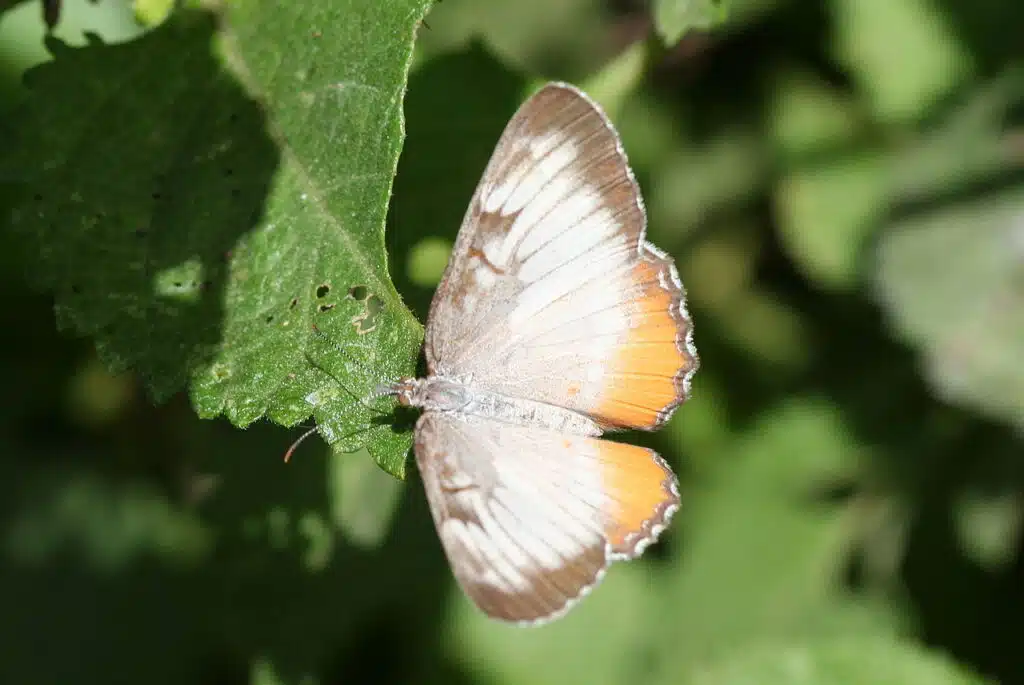
Central Southern states are where the Common Mestra species (Mestra amymone) is most common.
This butterfly has gray and white coloring. The gray of the male is light and it has darker grey veins that border the white areas of the wings.
Females also have white wings with grey upper wings and orange spots around the margins.
Common around woodlands and scrubland, this species is found in Texas in the highest numbers.
The edge of roadsides might be one of the places where people see this butterfly since it often feeds on lantanas.
11. Greenish Blue
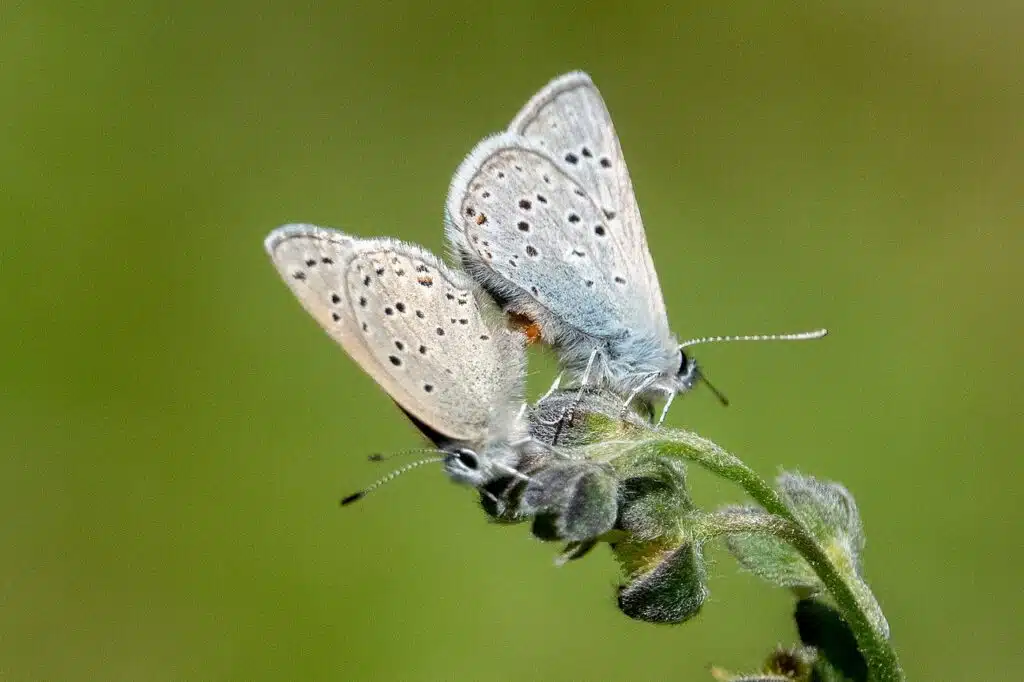
Greenish Blue (Icaricia saepiolus) represents a small butterfly species native to the US.
It lives in Northwestern states of the US but also Canada.
Most butterflies of the Greenish Blue species are blue. Females tend to be gray and even white.
Greenish Blue white females also show black spots across the wings.
This species has a reduced size with a wingspan of up to 28mm.
It might be one of the reasons it only has a flight season of 2-3 months in the summer.
Greenish Blue butterflies are seen in open fields where they fly at low altitudes. They feed on Trifolium.
12. Laviana White-Skipper
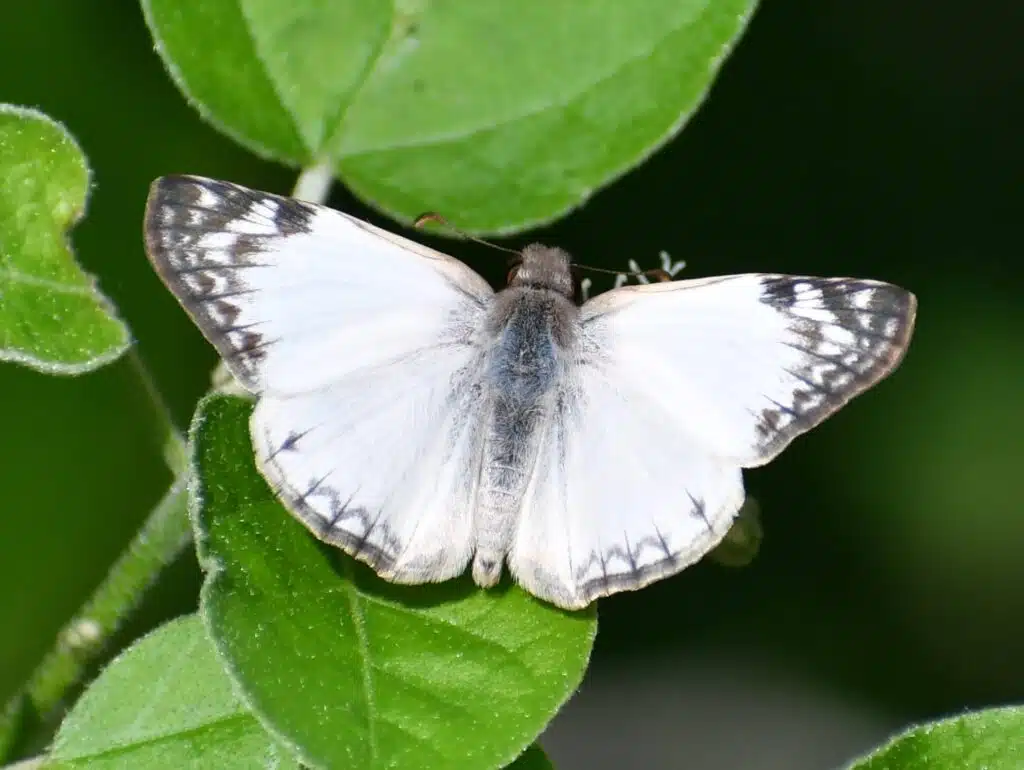
Both male and female Laviana White-Skippers (Heliopetes laviana) have a white wing with black or gray margins.
The margins of the female are typically wider than those of the male. The body of the butterfly is mostly gray.
Laviana White-skippers is a US native species and a Mexico native species.
They love tropical climates and they are mostly seen in the extreme South of the US such as Southern Texas.
Lanviana White-skippers remain active throughout the year in Texas.
They lay eggs on mallows which the caterpillar consumes as they go through each instar.
Adults feed on various flowers for nectar.
13. Northern White-Skipper
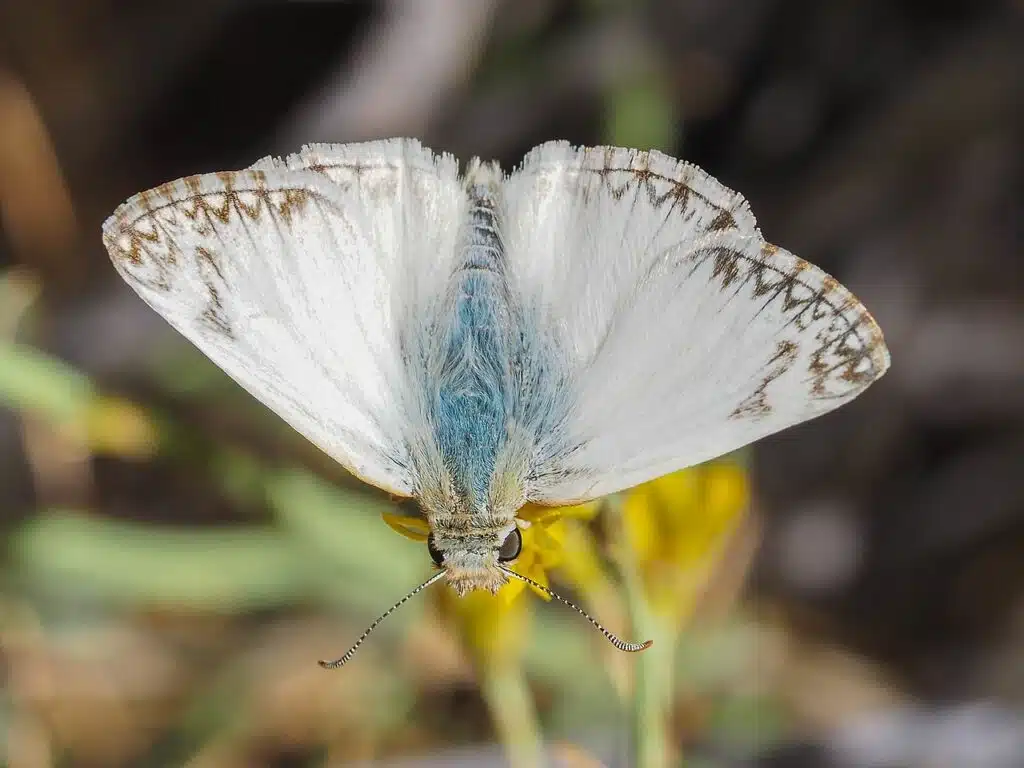
Northern White-skippers (Heliopetes ericetorum) is a mostly white butterfly species seen across the Western coast.
This species also shows black chevron-style markings on the wings.
Woodlands and open areas in woodlands are among the preferred habitat of this small species.
Growing to a maximum wingspan of 1.5 inches, these butterflies are normally seen feeding on mallow and then moving along to other flowers for nectar.
Northern White-skippers are also adapted to living in arid terrains such as those at high altitudes with limited flower selections.
14. Clodius Parnassian
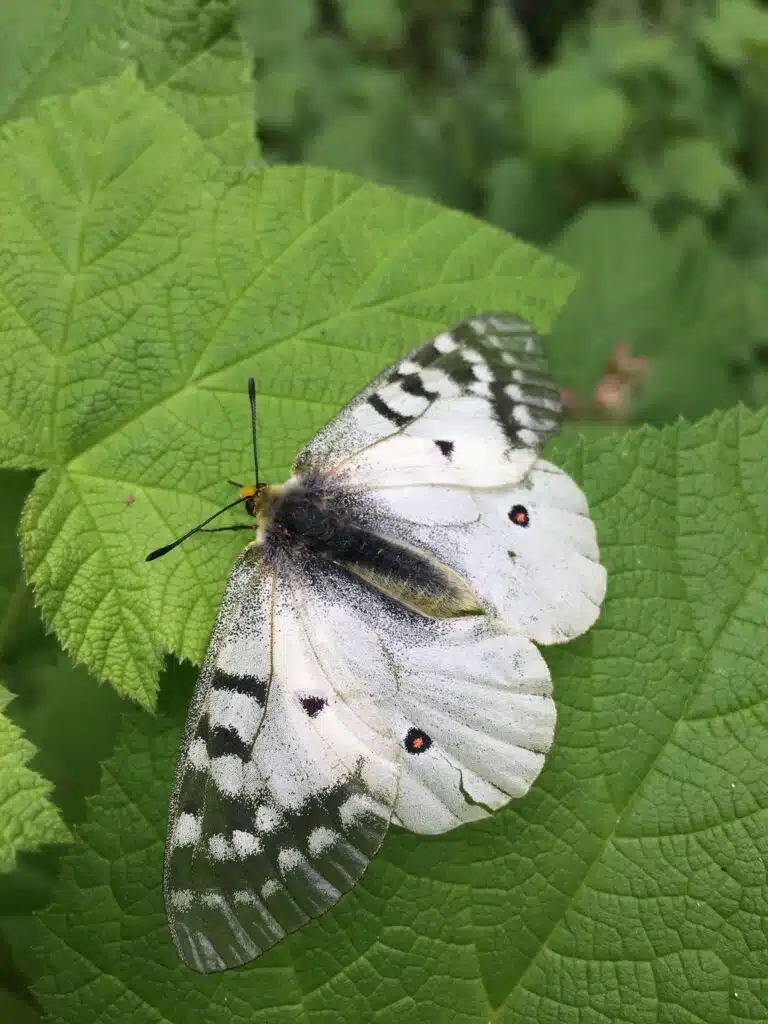
The Clodius Parnassian (Parnassius clodius) comes in many patterns and colors which makes it difficult to correctly identify the species.
Further differences are also seen in the coloring of males and females.
Most of these butterflies have a white-dominant aspect. White upper wings with gray or silver margins are specific to the butterflies.
Females tend to have wider margins.
The inner section of the wings is typically black, as is the body of the butterfly in most cases.
White is also seen on the hindwings together with 2 red, orange, or yellow marks with a thick black border.
As a swallowtail butterfly, the Clodius Parnassian is one of the most common white butterflies in the US that also lives at high altitudes and low altitudes.
Its habitat ranges from a height of 0 feet to a height of more than 7.000 feet.
15. Western Tailed-Blue
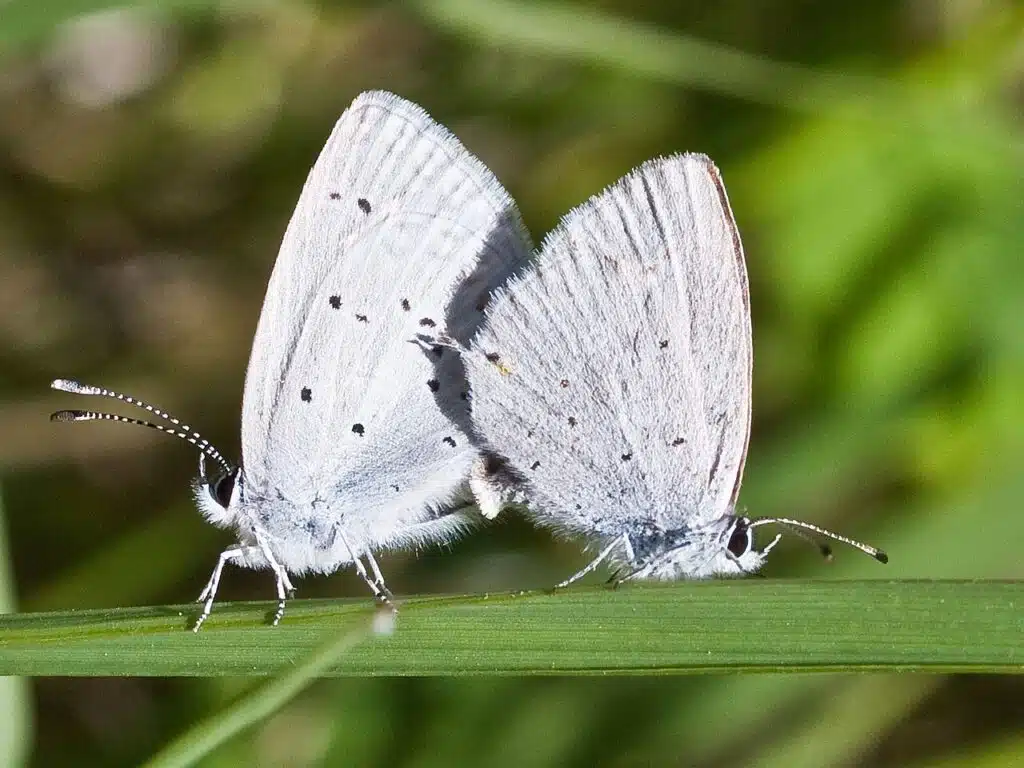
Western Tailed-Blue (Cupido amyntula) lives in Western territories from Alaska down to California.
This species is found in multiple colors including a mostly white color.
Western Tailed-Blue butterflies have black dots when they are white, blue, or gray.
Butterflies of the genus live in all types of forests in Western North America.
These butterflies also prefer habitats with plenty of peavines and vetches to feed on.
Prairies are areas where these types of plants are found but Western Tailed-Blue butterflies have to share these plants with many other native butterfly species.
16. Bernardino Blue
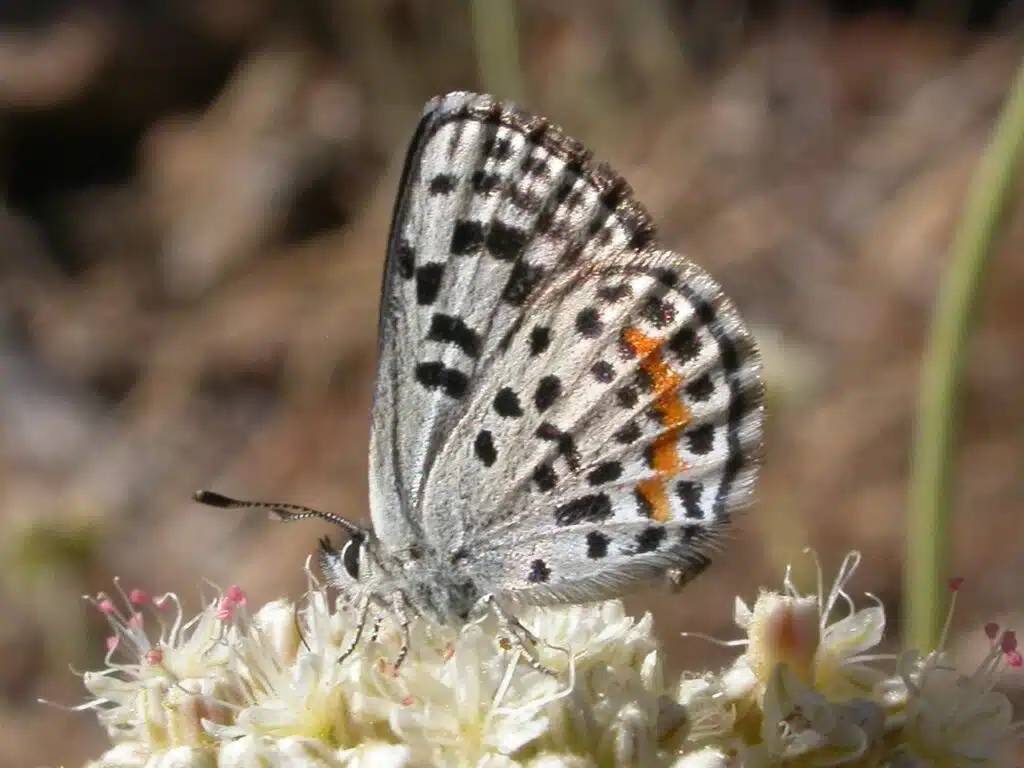
Bernardino Blue butterflies (Euphilotes bernardino) are named after the area of California they are most common.
They are also present in other Southwestern habitats and include the outskirts of Nevada and Arizona.
Common on dunes, this species faces a diminishing habitat in California.
You may still see it in arid areas where its white wings, black dots, and orange bands make it stand out.
This species lives a long life in the world of butterflies. It emerges at the end of February and it continues its flight until August.
17. Lupine Blue
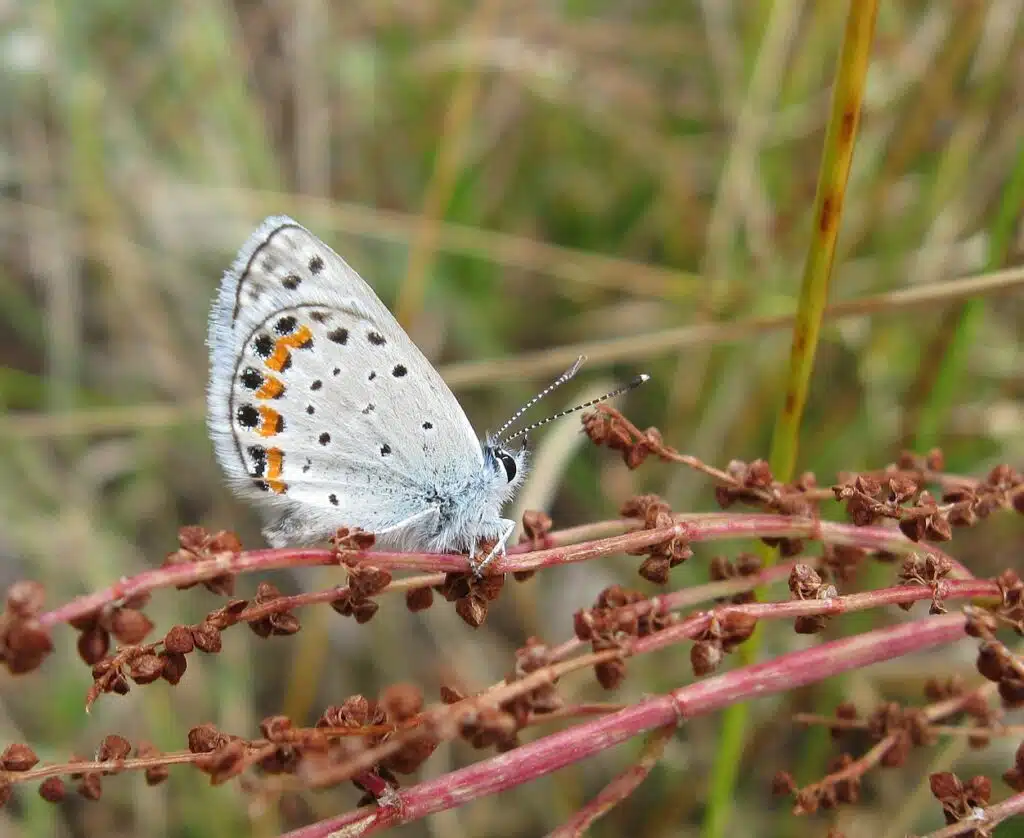
Lupine Blue butterflies (Icaricia lupini) are named after the plants they consume as adults.
This is a native US species with preferences toward mountainous regions on the West Coast.
With a wingspan of up to 29mm, Lupine Blues are among the small to medium butterflies that are found both in blue and white colors.
The female of the species is seen in a white-dominant color while the male is mostly blue with black and white margins.
Lupine Blue appears in multiple broads per year.
They first emerge in March but their season is short with the flight being limited to July and not August as in the case of the Bernardino Blue.
18. Pine White
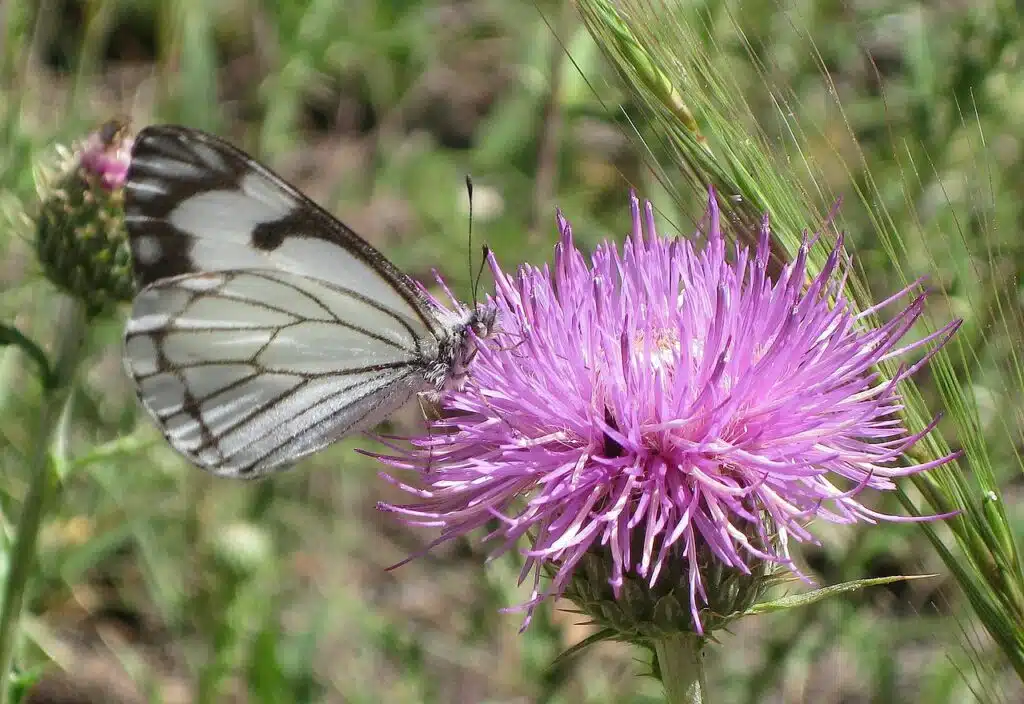
Pine White (Neophasia menapia) sometimes share their habitat with Lupine Blues.
These white butterflies are highly common in the mountainous regions of Western North America.
Unlike Lupine Blues, Pine White butterflies are white both in the case of males and females.
These butterflies have a wingspan between 1 and 2 inches.
Black margins and black veins are visible both on males and females.
As their name implies, Pine Whites are seen in pine forests. These white butterflies are also seen across mixed forests such as pine and fir forests.
These butterflies eat various types of nectar they find in these forests such as rabbitbrush nectar.
Caterpillars of the Pine White grow on the trees in these woodlands. However, the caterpillar bears no color resemblance to the adult.
Pine White caterpillars are green with lateral yellow bands.
19. Northern Azure
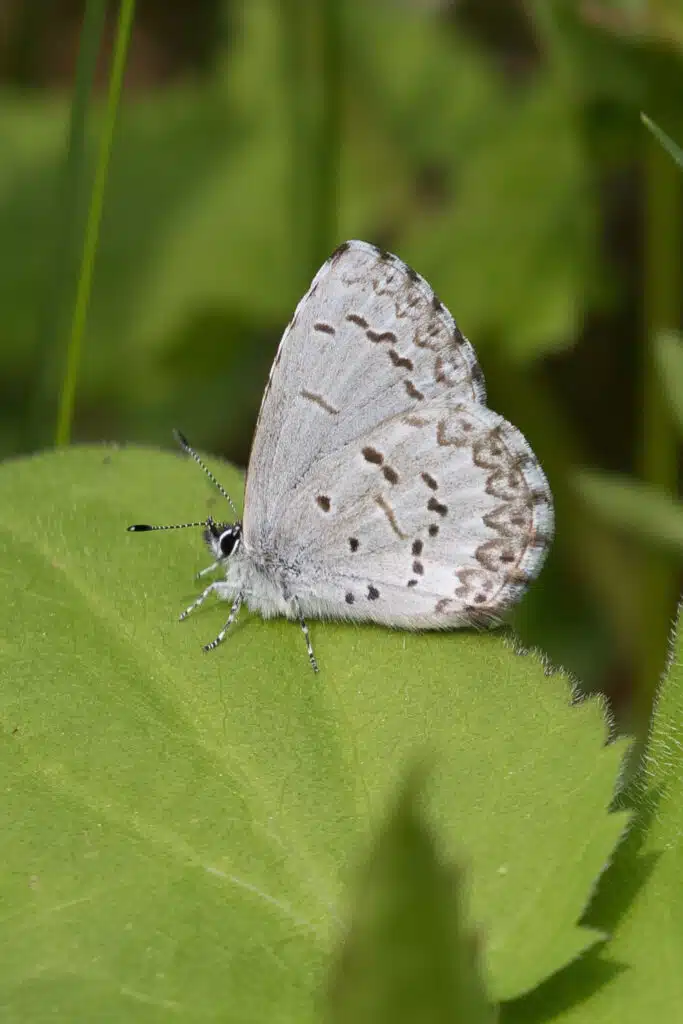
The female Northern Azure (Celastrina lucia) can have an off-white color as opposed to the blue color of the male.
Males have white margins and a wingspan of up to 35mm.
Northern Azures are US native species that live in Northeastern parts of the country.
You can find these butterflies around multiple types of shrubs. Wild blueberries are among the favorite hosts of Northern Azures, especially for their caterpillars.
Adults emerge in April from these shrubs and start feeding on the nectar of various other dwarf shrubs.
20. Rocky Mountain Parnassian
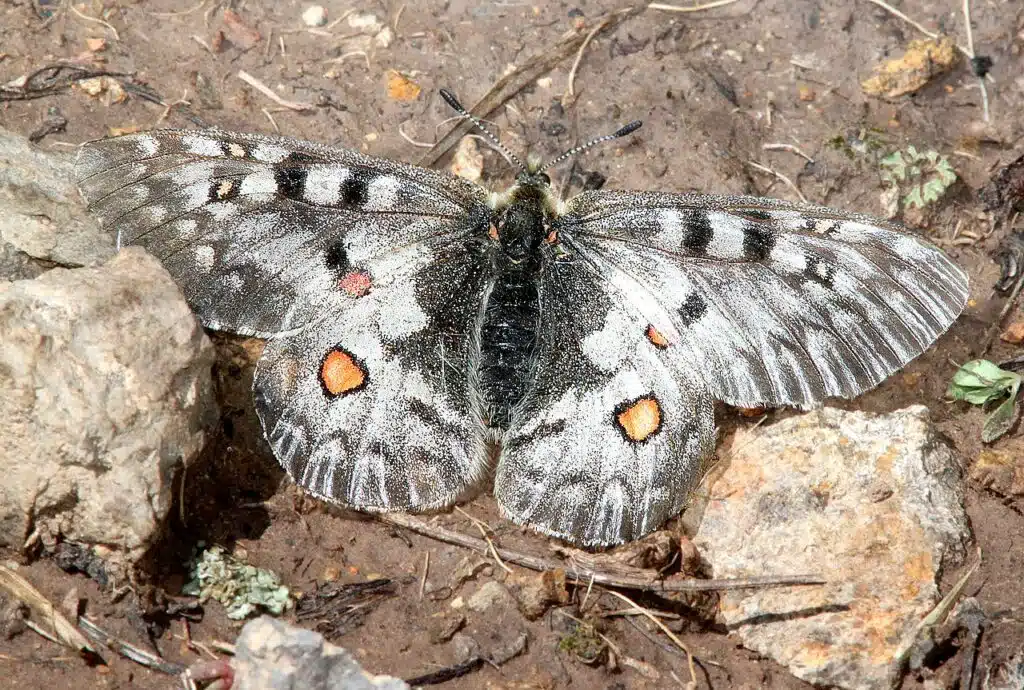
As its name implies, the Rocky Mountain Parnassian (Parnassius smintheus) is a species that lives around The Rocky Mountains.
However, this species isn’t specific to the woodlands of these long-stretch mountains as they prefer the open areas at high altitudes.
Butterflies of this genus are white with black stripes and bands.
Males are known to be highly selective of their territories as they fly to assess and compare food availability in certain pastures.
Male Rocky Mountain Parnassians have higher chances of being spotted as these butterflies fly a lot more than females.
Higher energy consumption prompts male Rocky Mountain Parnassians to move along to find the source of nectar such as rosaceae flowers and goldenrods.
21. Large Marble
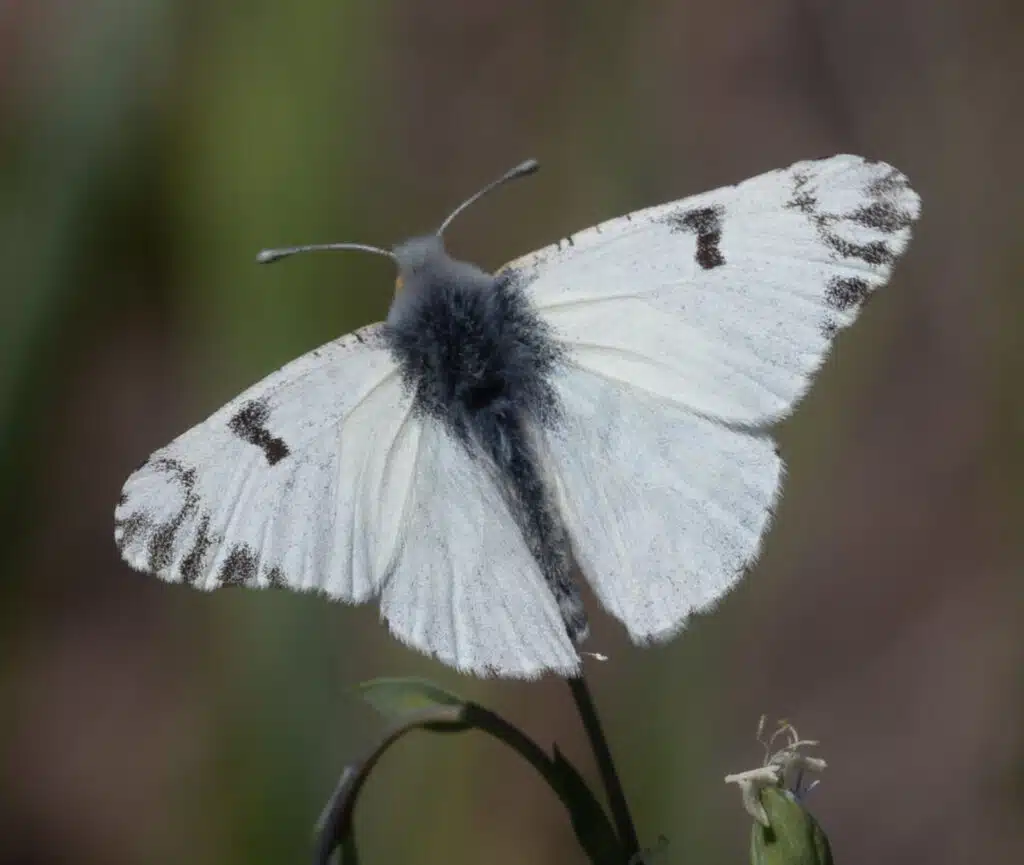
Large Marbles (Euchloe ausonides) get their names from their marble-like ventral side patterns and colors. The dorsum of this species is mainly white with dark and brown spots along the edges of the wings.
Large Marbles live in vast open territories across Western US and Western Canada states.
Butterflies of this genus have a few sub-species that also live in North America.
Most types of Large Marble butterflies are known as migrators. They migrate over long distances to switch up diminishing flower nectar sources and to find conditions where the weather isn’t as harsh.
22. Western White
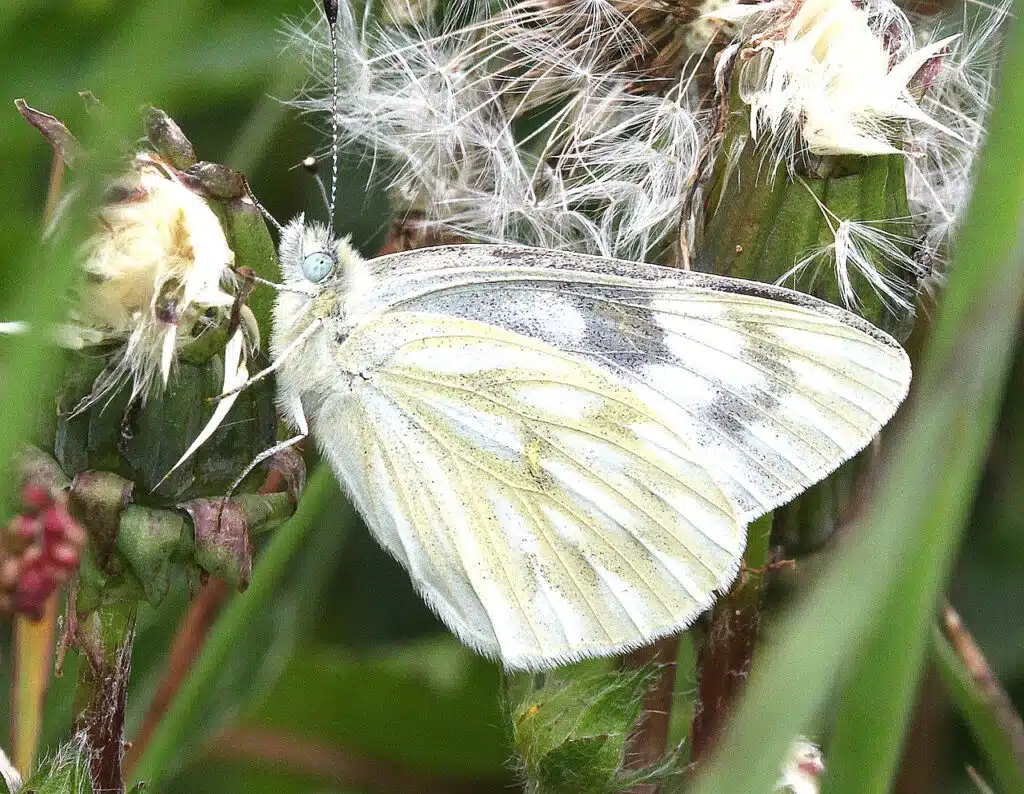
Western Whites (Pontia occidentalis) are butterflies common to the Northwestern states. They have a white base color for the wings, a black body, and multiple black or gray marks across the upper wings,
Mustard is one of the common plants the Western White relies on for food. It’s also a common pest of cabbages as its caterpillar feeds on cabbage.
Western Whites have 2 flight seasons so they can create considerable damage to cabbages. This species remains active until July in the first brood and they later to the end of the summer with the second brood.
Western Whites are some of the larger white butterflies in the Northern parts of the US with a maximum wingspan of up to 53mm.
23. West Virginia White
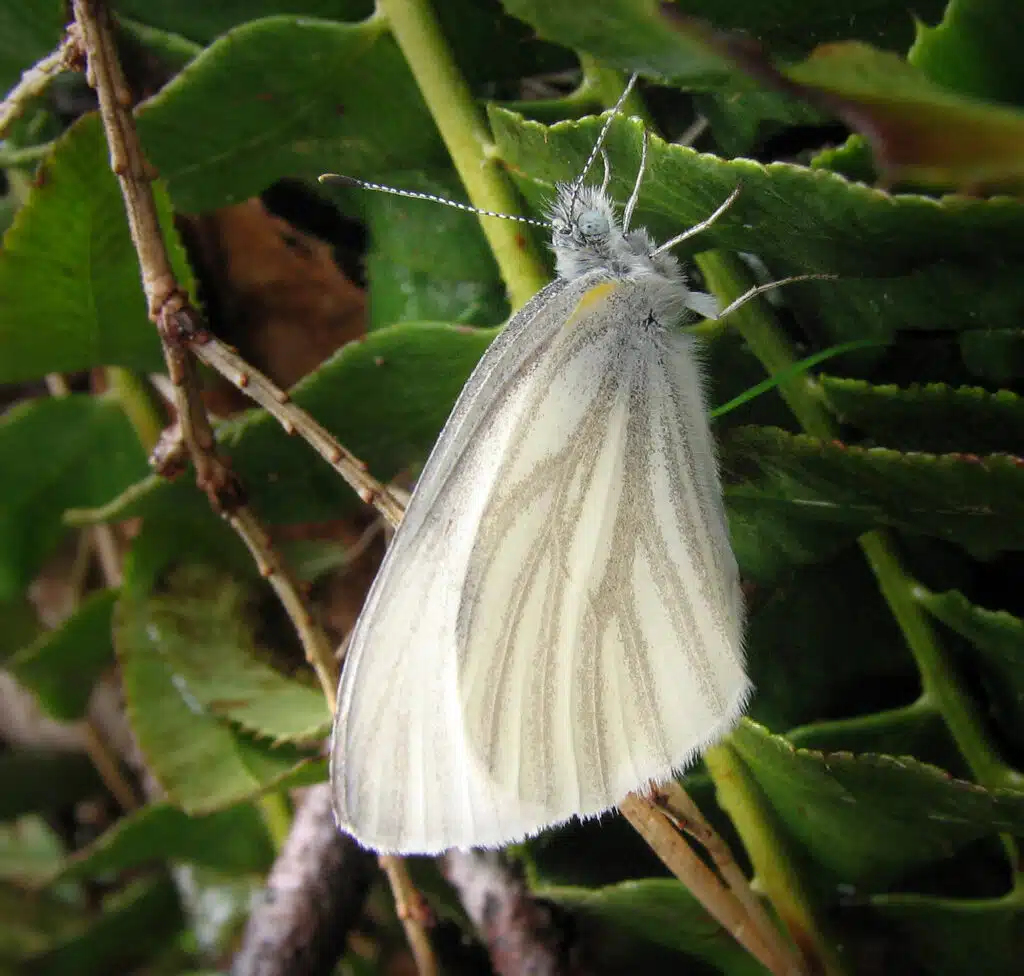
Common in the Northeast and the area of The Great Lakes, West Virginia Whites (Pieris virginiensis) are a white butterfly species found in woodlands.
The white color of the wings is interrupted by off-white patterns that look like wide veins.
Butterflies of the family are highly dependent on woodlands on woodlands for their affinity to bittercresses.
West Virginia White might also be known under different names locally. Some call it the Toothwort White for its occasional habit of laying eggs on Toothwort alongside bittercresses.
These are wildflowers the adult female West Virginia White lays eggs on.
Some highly similar plants also attract females but they aren’t suitable for caterpillars of the species.
24. Becker’s White
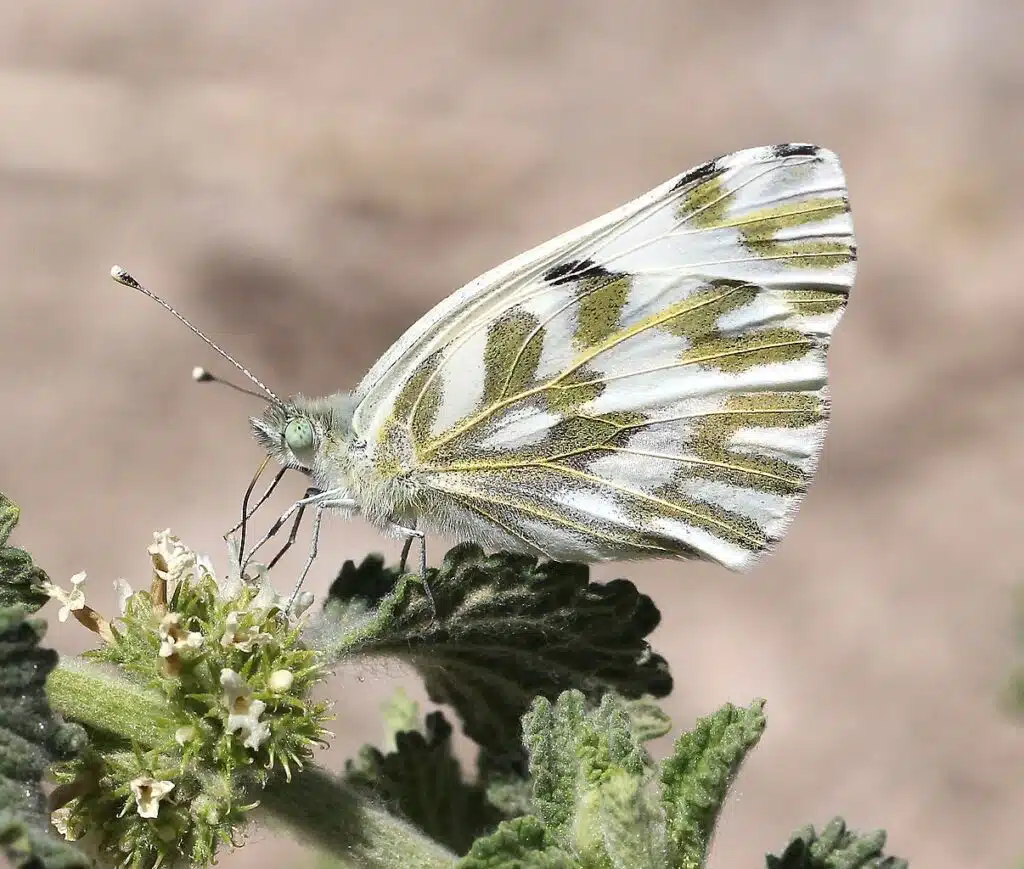
Becker’s White butterflies (Pontia beckerii) are native white or mostly white species.
These butterflies have white wings with a central off-white section closer to the body and tiny black spots along the upper wing margins.,
Becker’s Whites are native to the West Coast.
The range these butterflies live in is extensive and not limited to the US. They also live in Canada in British Colombia.
Becker’s Whites are further reported in Mexico’s Baja California.
Bladderpods are the small shrubs most commonly associated with this species. These host plants are specific to dry areas such as the sides of roads as well as other dry terrains at various altitudes.
Bladderpods are a host species of Becker’s White up to an altitude of a few thousand feet.
25. Karner Blue
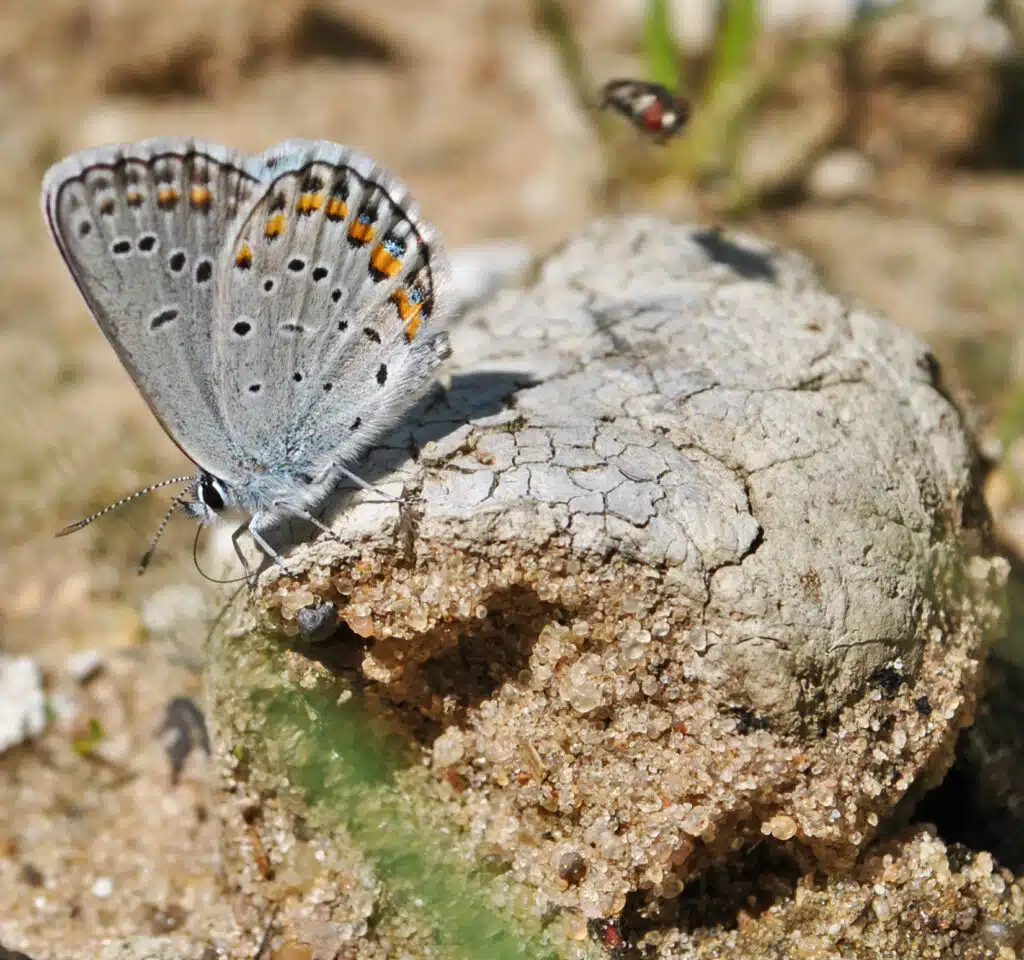
This large butterfly (Plebejus samuelis) is only seen in a few states in Northeastern territories including New York.
Most Karner Blue butterflies are seen in oak savannahs. These are open areas with not too much vegetation where oak trees are the dominant tree.
Butterflies of this genus are dependent on lupines in these areas and are typically found where lupines are found.
Various species of grass are also hosts to Karner Blues. These butterflies are sometimes known for causing damage to ornamental grass in Wisconsin.
26. Mustard White
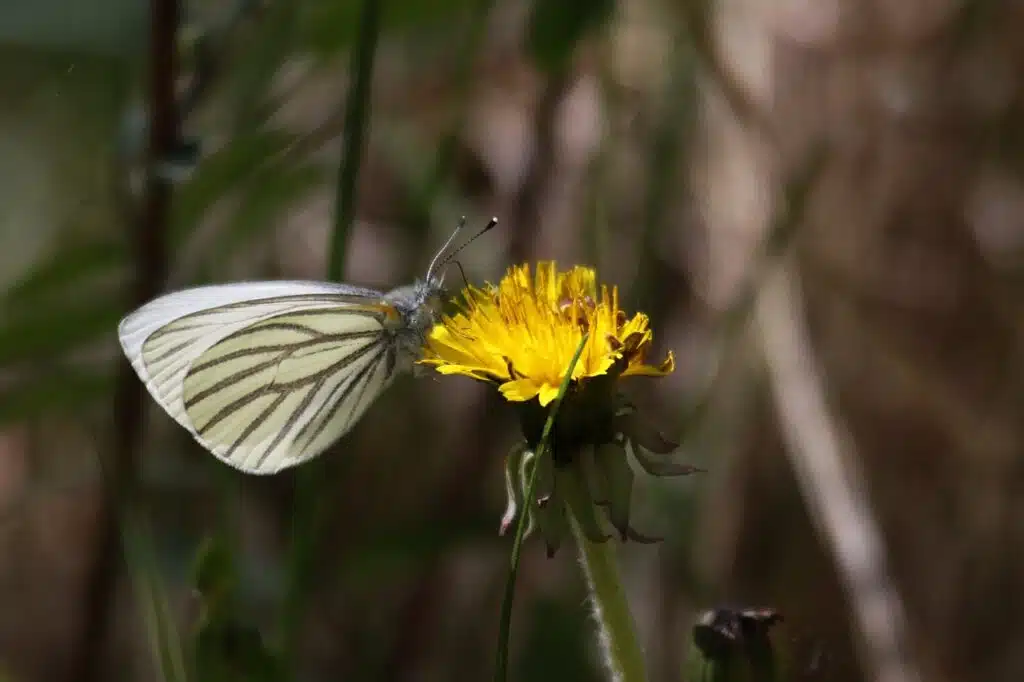
Mustard Whites (Pieris oleracea) are white butterflies native to Northwestern US territories.
These butterflies have white wings with dark gray vein-like patterns across. Mustard Whites are small butterflies with a common nature but a threatening nature.
These butterflies are known to suffer from the spread of toxic mustard plants since not all mustards are suitable for their larvae.
The Mustard White is a species that’s slowly adapting towards garlic mustard, a common safer alternative for its eggs.
This process takes time and the Mustard White butterfly is one of the possibly endangered white butterflies in the Northwest shortly.
27. Spring White
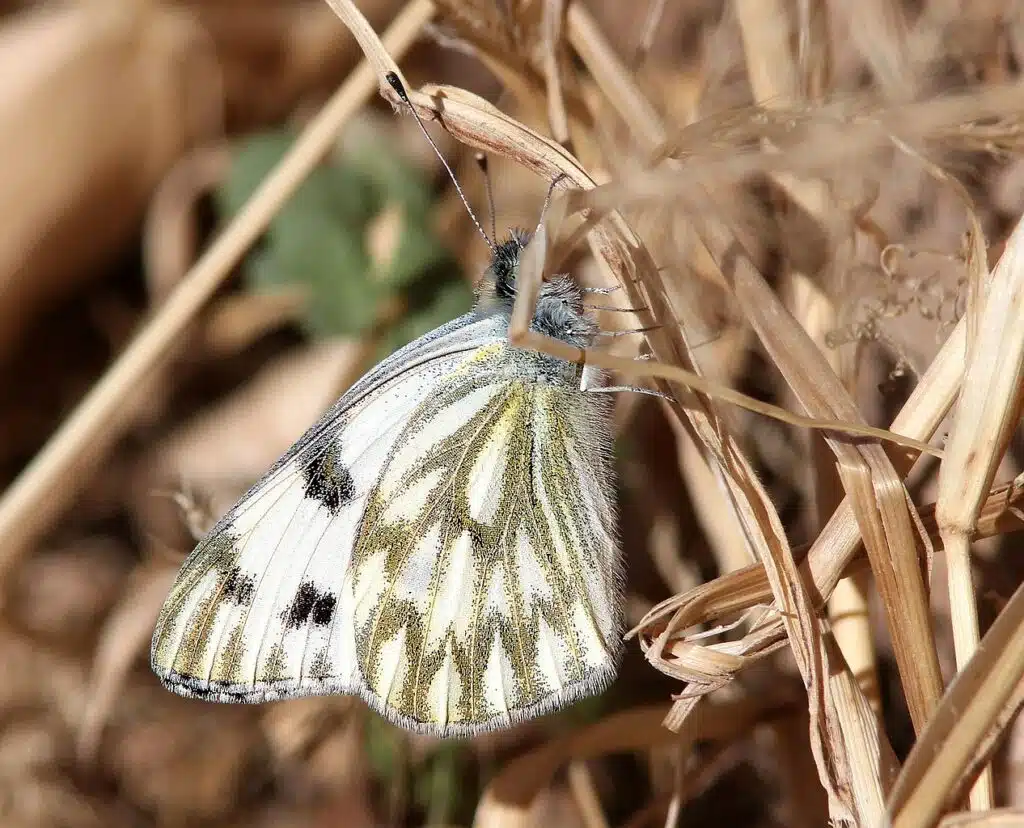
Spring White butterflies (Pontia sisymbrii) are a species associated with the mountains in Western US states as well as in Canada.
The species has white wings both in the case of males and in the case of females.
Some small differences in identification as seen in the upper wings from the lower wings.
This species has black vein-like patterns across the upper wings and wider patterns of a similar nature on the hindwings.
Like many other Western white butterflies, Spring Whites are also associated with mustard family plants as they consume mustard nectar.
Spring Whites remain a small species in the West with a varying wingspan between 31 and 40mm.
28. Turk’s-cap White-Skipper
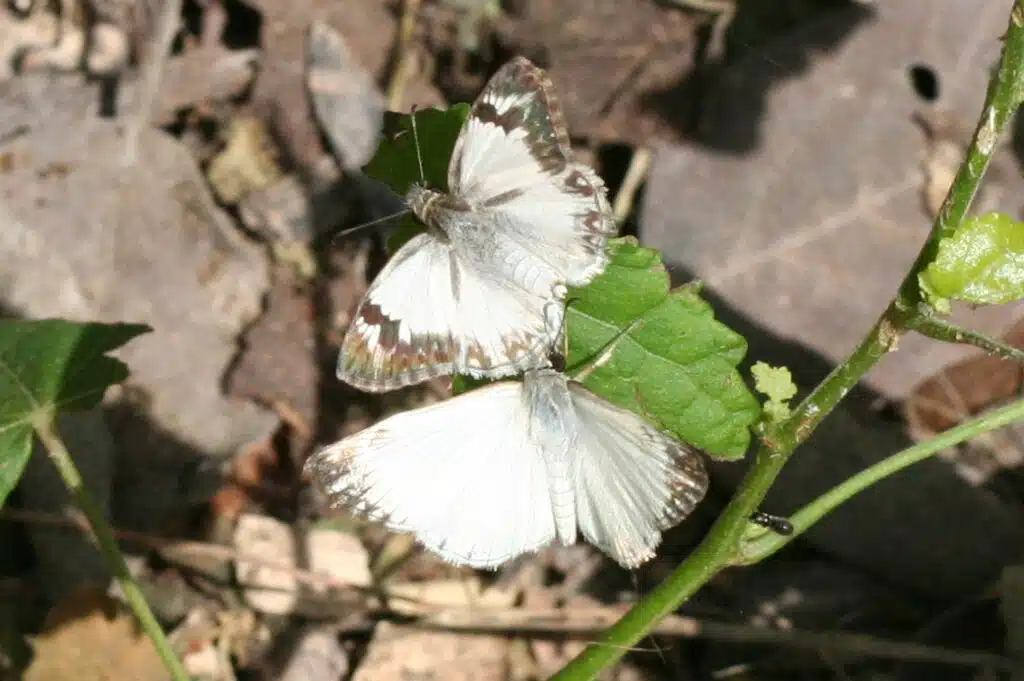
The Turk’s-cap White-skipper (Heliopetes macaira) is a species common in Texas. It’s only native to Texas as most butterflies of this genus live in Central America.
The white coloring is specific to the butterfly. Brown or black marks across the margins of the wings are further distinguishable and contrasting to the pure white of the wings and of the body.
This species is small to medium among white butterflies with a wingspan of up to 35mm.
You can sometimes find these butterflies around hibiscus flowers in Texas as females use these flowers to lay eggs on.
Adult Turk’s-cap White-skippers then feed on flower nectar from other flowers as well.
29. Southwestern Orangetip
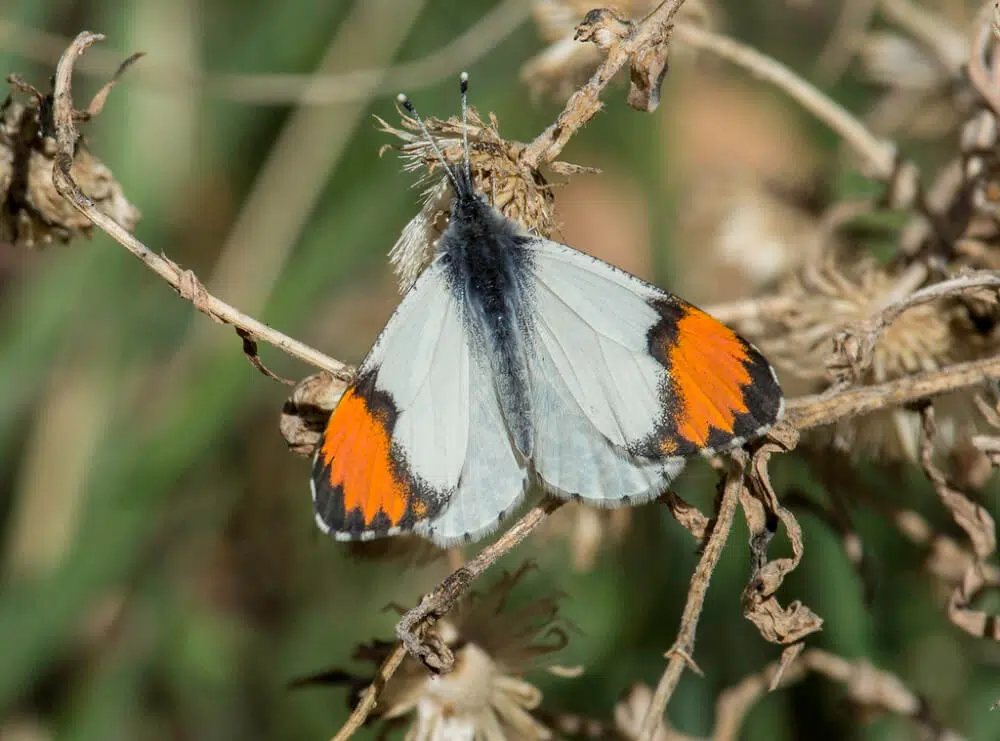
Southwestern Orangetip butterflies (Anthocharis thoosa) are known both for feeding on mustard and for having white coloring.
This species has white wings with orange sections on the margins of the upper wings.
The hindwings have a marbled look which is also white or white and brown depending on the sex of the species.
Butterflies of this genus mainly live in the Southwestern parts of the US.
They live in or around juniper forests and can further be distinguished by their reduced size as they have a wingspan of just over 1 inch.
Feeding on various types of plant nectar, this species is present in a habitat that expands from California to Wyoming.
30. Desert Marble
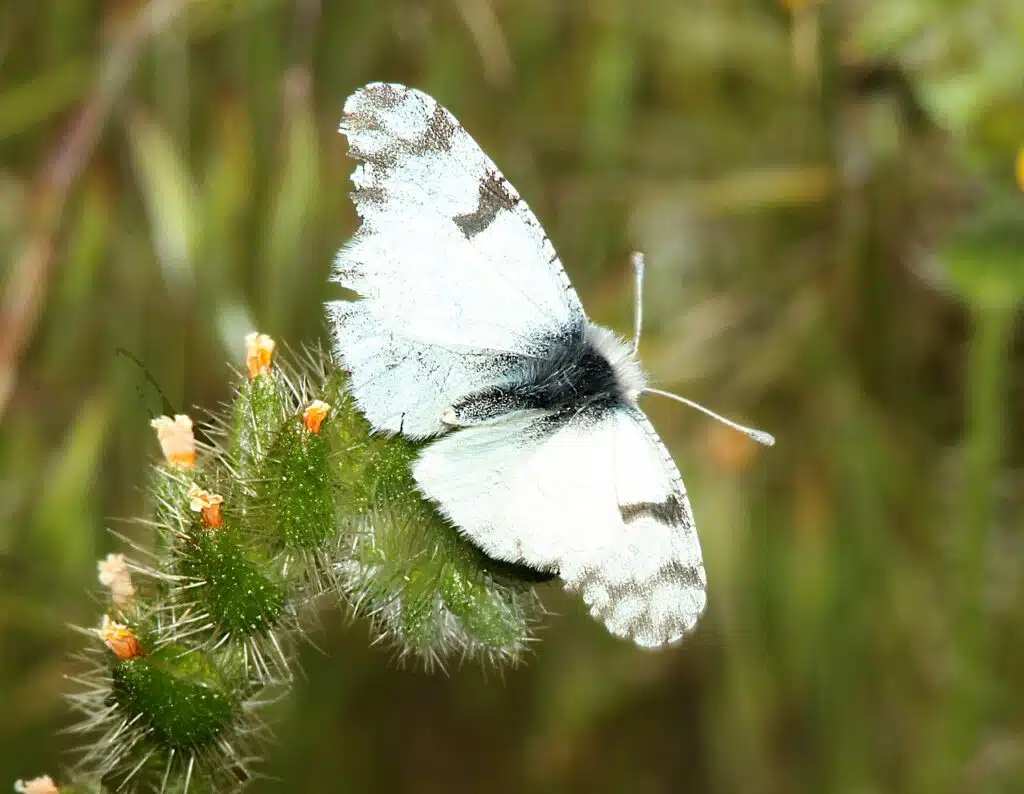
Also common in juniper woodlands as the Southwestern Orangetip, Desert Marbles (Euchloe lotta) also live in deserts and arid areas of the US.
This native species has white wings with green or gray veins across the wings.
Gray veins are seen on the dorsal side of the wings while green veins are specific to its ventral side.
The species has a comparable wingspan to many other white native butterflies. It grows to a wingspan of up to 40mm.
You may see the species in deserts, canyons, and other rocky areas.
Adults feed on most types of flowering plants in these waterless habitats such as elegant rockcress flowers.
31. Florida White
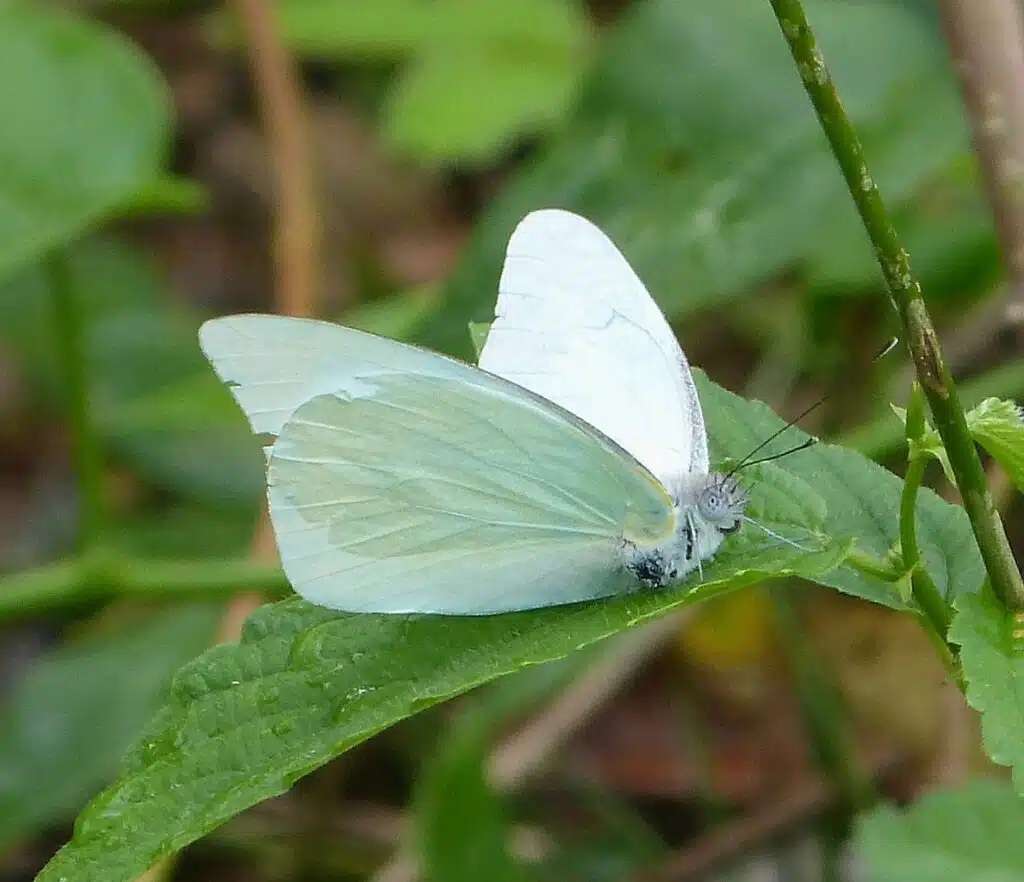
Commonly found around Texas and nearby states, the Florida White (Glutophrissa drusilla) is native to Florida, as its name implies.
This is one of the largest white butterflies in the US as its reaches a wingspan of up to 55mm. The entire Drusilla family of butterflies is known for having a long wingspan that even stretches to 77mm.
White butterflies of this genus have mostly white wings or white wings with black and yellow marks depending on the gender.
The butterfly has all-white wings with a black body or white wings with yellow spots close to the body and black margins on the upper wings.
All-white underwings are specific to this species which makes it resemble white leaves on white flowers it consumes the nectar of.
32. Giant White
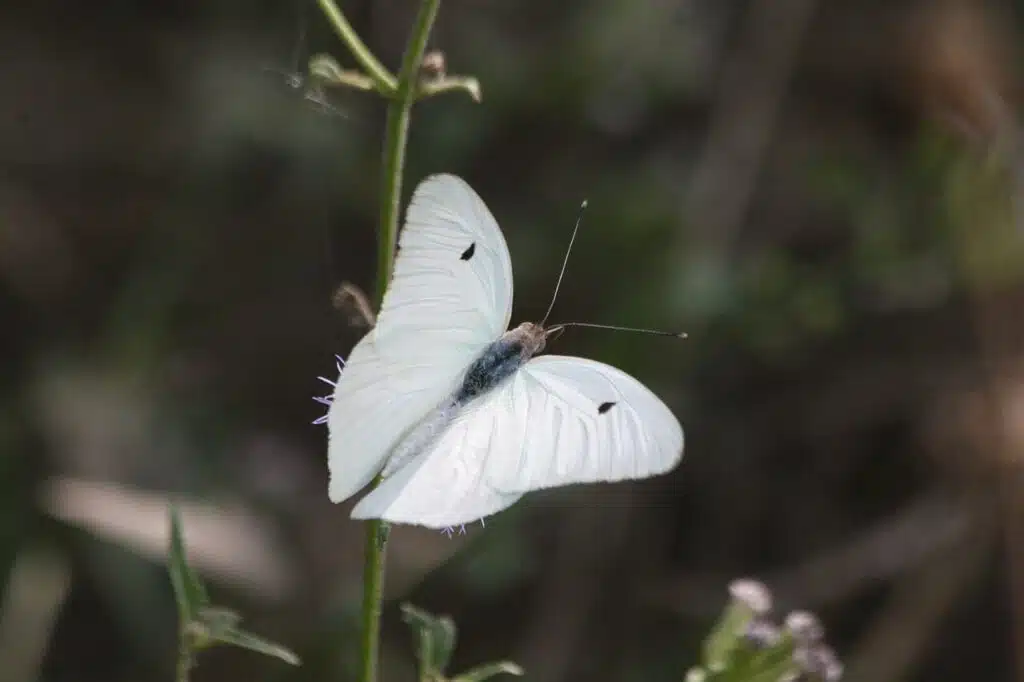
Found in subtropical forests in North America, the Giant White (Ganyra josephina) is one of the largest white butterflies native to the US.
This species has a considerable wingspan of up to 96mmm.
Such a larger wingspan also means the Giant White is a slow-moving butterfly.
Its coloring is almost purely white on the wings. Just 2 small black dots decorate its upper wings.
The body is black on the upper side and white on the lower side.
Giant White butterflies have a brown or dark gray head.
Common from September to December in the extreme South of the US, this species feeds on the nectar of wildflowers and typical flowers grown in gardens.
The specie is found around the lantana flowers of Southern Texas.
33. Gray Marble
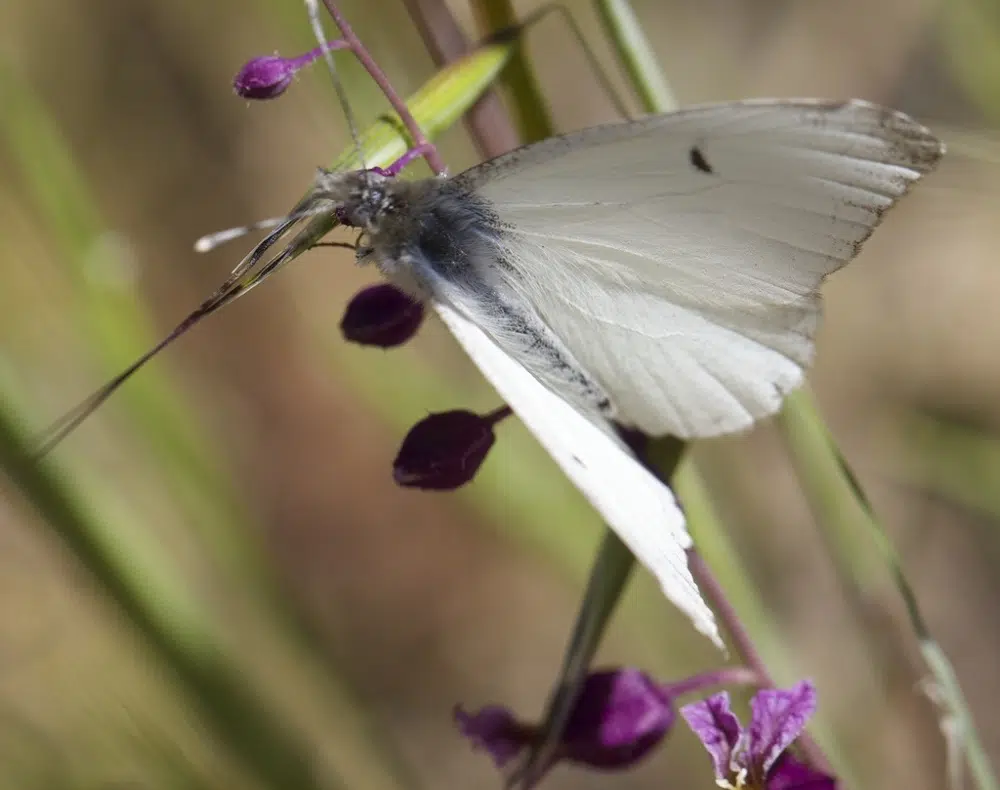
Gray Marbles (Anthocharis lanceolata) are technically native to the entire Western Coast of the United States.
But this species is mostly seen on California Coast.
You can identify Gray Marble by the off-white coloring of the species. The upper wings are white with gray bands across the margins.
The hindwings of the species have a white color with a marbled pattern than inspires its name.
The margins of the hindwings are also gray.
The further gray coloring is specific to its body and the immediate area of the wings surrounding the body.
A couple of small black dots on the inner forewings can further be seen on male Gray Marbles.
34. Pallid Blue
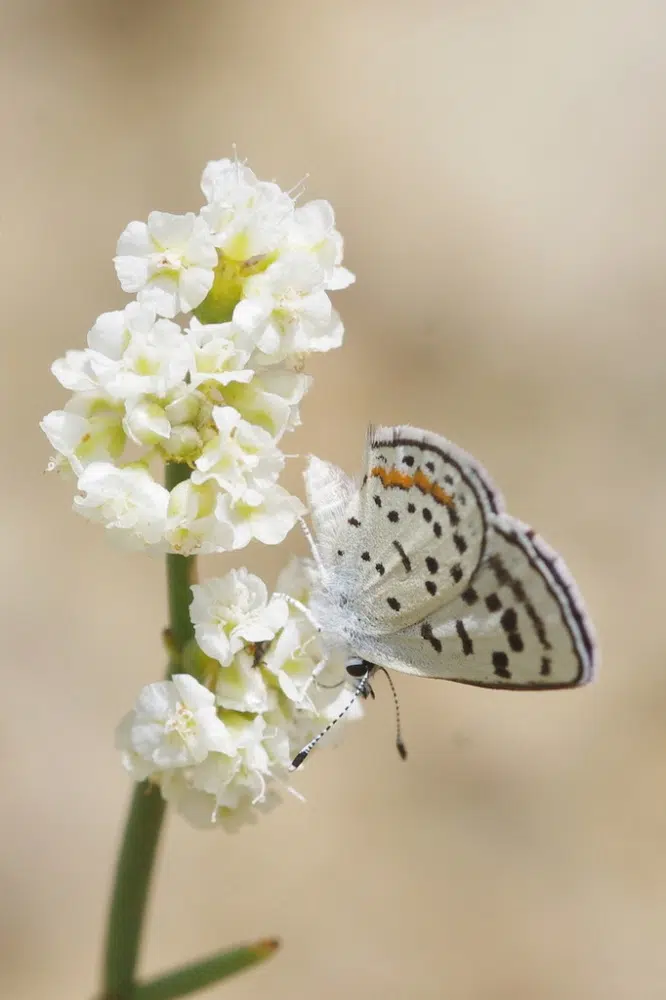
The Pallid Blue (Euphilotes pallescens) is a native US species seen in multiple color variations including base white coloring.
These butterflies have white wings with gray overlays or gradient gray to white wings depending on their region.
Small black dots are further distinguishable on the wings of the species.
Pallid Blue butterflies also have orange bands on the hindwings which makes them stand a bit more. These butterflies are also seen in a blue base color.
Common in areas with short vegetation, the Pallid Blue species is known for laying eggs on multiple types of buckwheat.
35. Chiricahua White
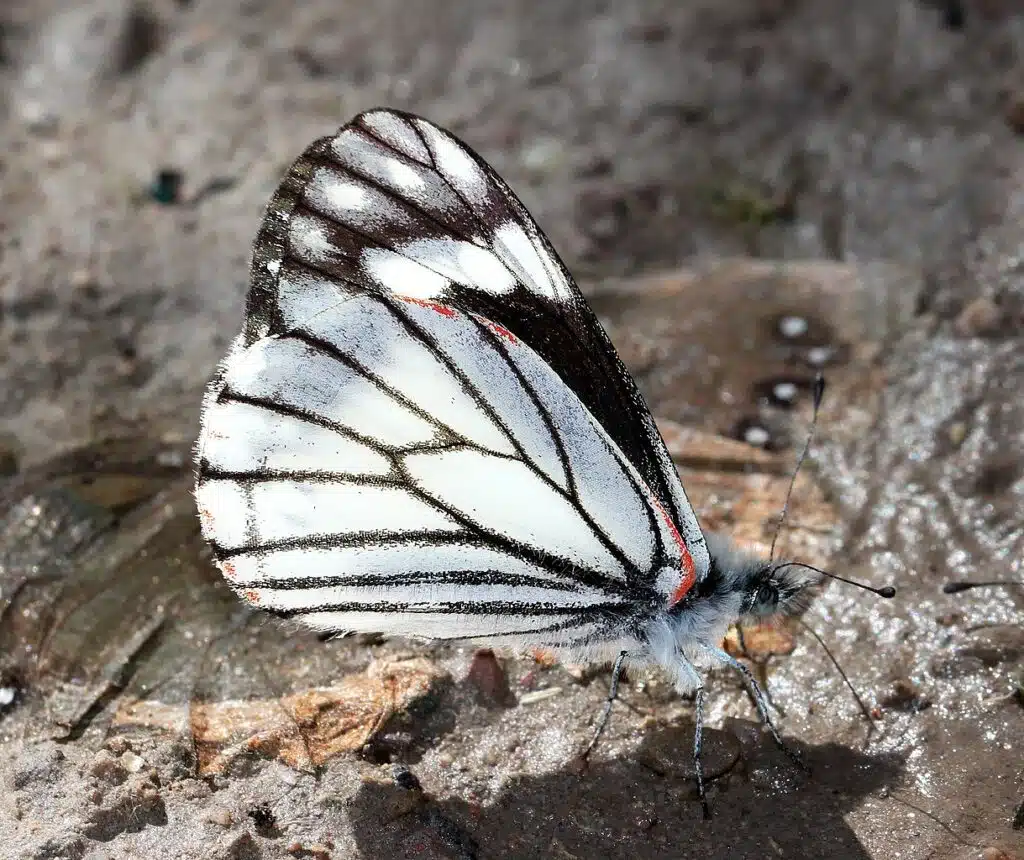
Chiricahua White butterflies (Neophasia terlooii) have a white dominant wing color. Black coloring is also specific to a wide area of its wings, particularly of its forewings.
This butterfly species also has visible black veins on its hindwings.
You can only find this white butterfly in the extreme South of the US, particularly in New Mexico and Arizona.
It’s here that the Chiricahua White butterfly is one of the largest white butterflies as it has a wingspan of at least 45mm that can be as long as 58mm.
36. Arctic White
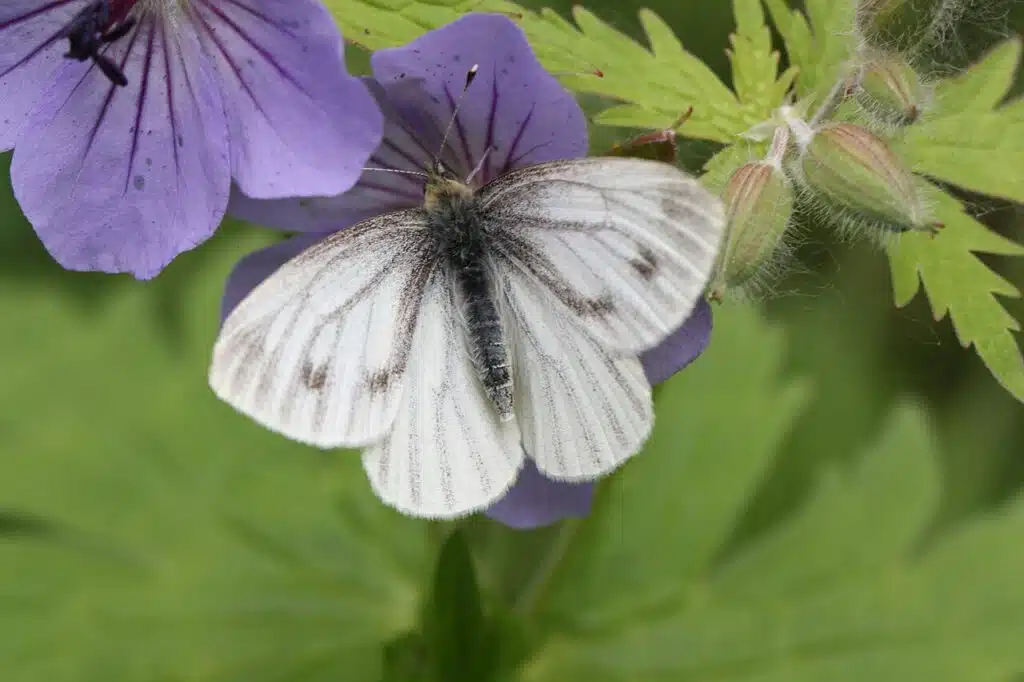
The Arctic White (Pieris angelika) is one of the most common types of white butterflies in the Northern US territories up to Alaska.
This species has adapted to temperate climates with the capacity to move across large habitats such as Yukon.
You can identify the species by its medium-length wingspan. Arctic butterflies have a wingspan of up to 42mm.
These butterflies have white wings and gray to black veins across the wings.
The body is black as are the antennae.
Yellow, cream, or off-white coloring is also specific to the ventral color of these butterflies. A larger color variation on the ventral side is specific to the male Arctic White.
37. Phoebus Apollo
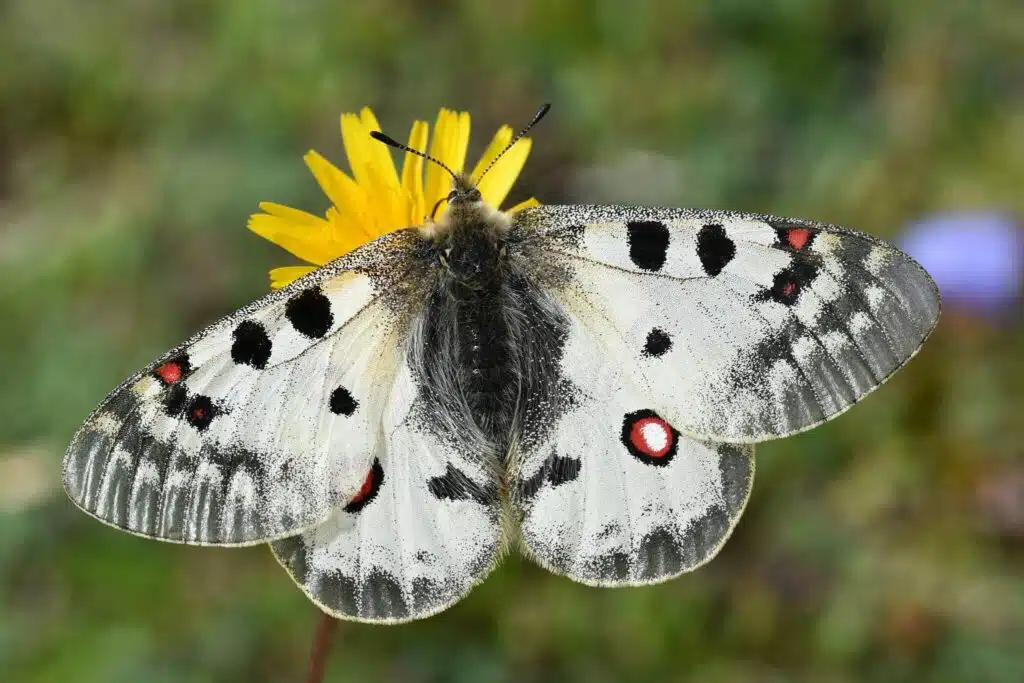
The Phoebus Apollo (Parnassius phoebus) is one of the large white butterflies with intricate patterns which makes it a species difficult to identify.
This butterfly has a few unique coloring traits but it also shares some of these traits with other species.
White is the main color of its hindwings and forewings.
Gray margins and brown bands are also seen on its forewings while the hindwings only show gray margins.
The butterfly also has short black bands on its upper forewings.
2 red dots are further distinguishable and contrasting on their hindwings. These red dots have black borders and white central spots.
The body of the species is mostly dark gray but it can appear black in low light.
38. Sierra Nevada Parnassian
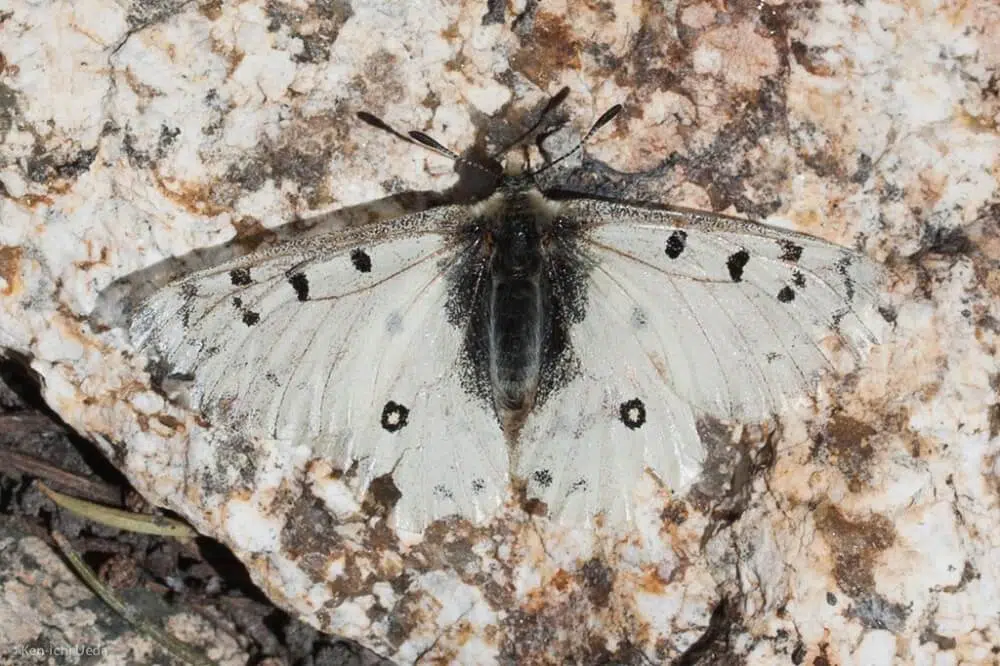
The Sierra Nevada Parnassian (Parnassius behrii) is a species that resembles the Phoebus Apollo in color patterns on its white wings.
As its name implies, this is a species mostly tied to The Sierra Nevada. A California native, the Sierra Nevada Parnassian feeds on asters and other types of flowers that grow in these arid climates.
Rock slides are a specific habitat for the species. However, the Sierra Nevada Parnassian is also seen along various water sources as there are higher chances of encountering vegetation in this habitat.
The wingspan of the species varies from 1 to 2 inches.
It has white basal color for the wings with black and gray patterns all across the forewings and the hindwings.
Yellow eyespots are seen on the lower hindwings which give the species contrast.
This butterfly has yellow eyespots similar to the red eyespots of the Phoebus Apollo.
39. Holly Azure
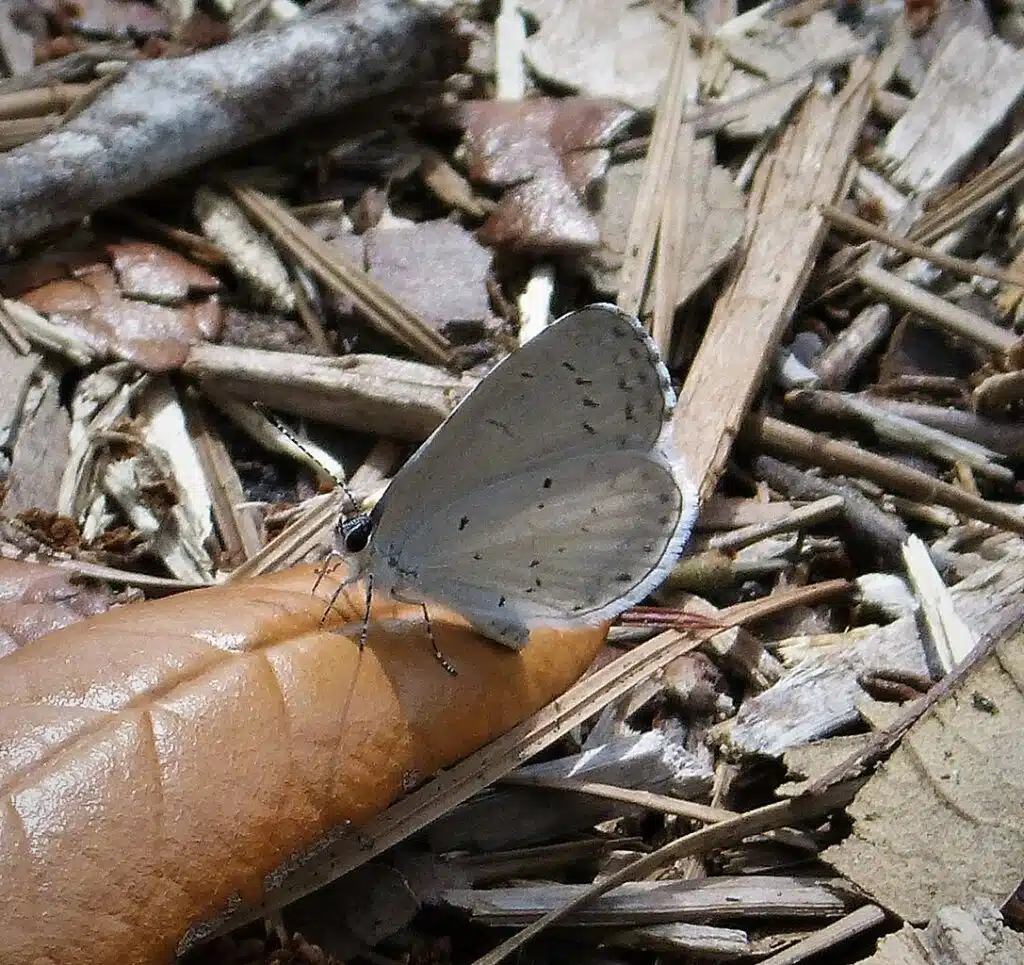
Holly Azures (Celastrina idella) are among the rare white butterfly species seen on the Atlantic Coast of the US.
This butterfly is often seen in white or off-white color with black dots across its wings.
It has thin black margins bordered why all-white coloring.
Seen in multiple locations from Atlanta to Georgia, Holly Azures are a common sight in low shrubs and fruity shrub habitats.
This is why the adults of the species feed on multiple types of blueberry and chokeberries.
The species is also seen on trees. Red maple is one of its host trees.
40. Avalon Scrub-Hairstreak
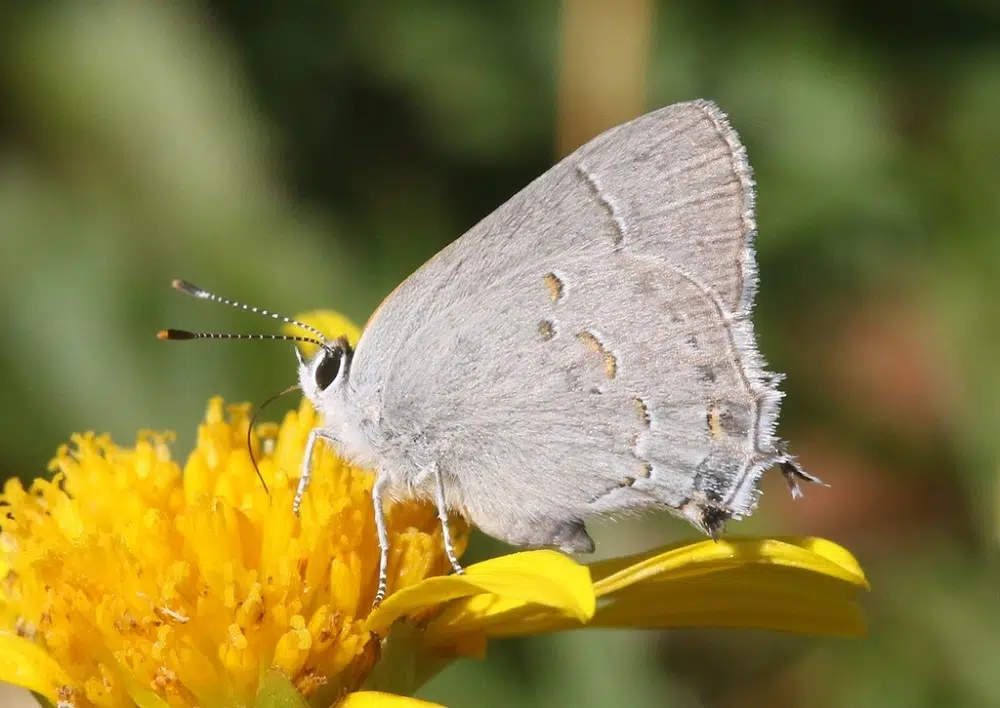
Avalon Scrub-Hairstreak butterflies (Strymon avalona) have an almost completely white underside.
These butterflies have orange half-moon marks with orange and black eyespots on the margins of their ventral wings.
The dorsal color of the species is mostly black with a reduced percentage of white marks.
Butterflies of this species appear to mimic the white flowers they visit for nectar when they keep their wings together.
The range of this species is highly limited and it also protects the Avalon Scrub-Hairstreak from common butterfly predators.
The species only lives on Santa Catalina Island in California.
41. Anna’s Blue
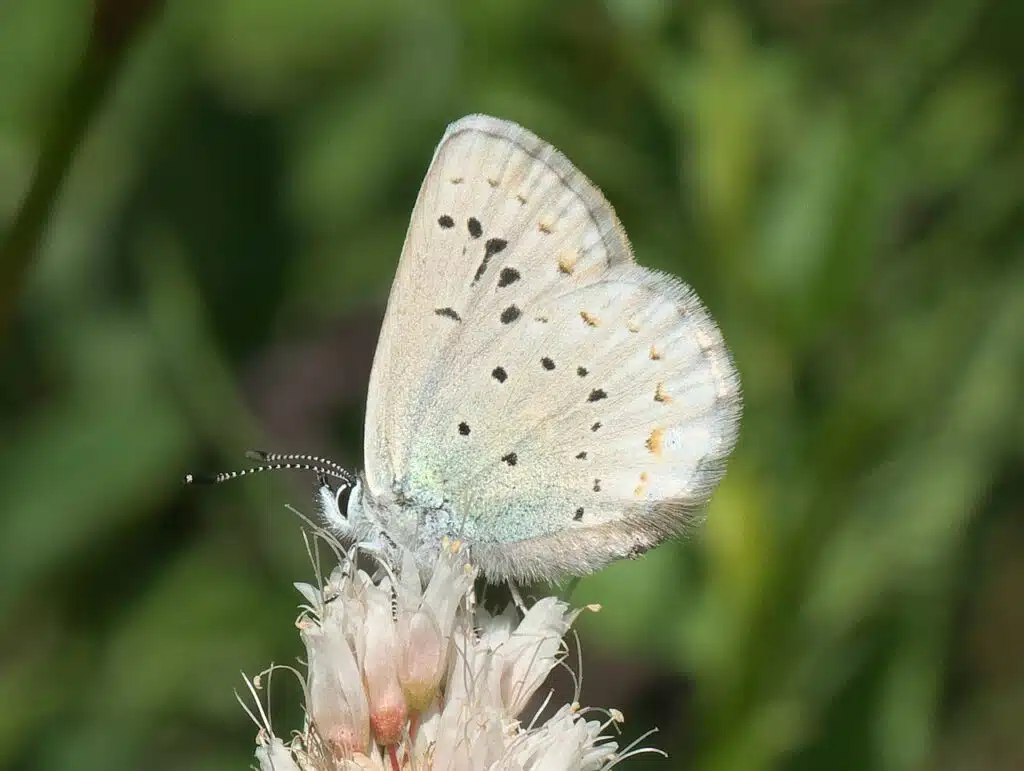
Anna’s Blue (Plebejus anna) is another native white and off-white butterfly species on The West Coast.
This species can appear white, off-white, and even yellow. Its white color is dominant.
Butterflies of the species have white wings with black dots. A find black margins are also visible on the wings. These butterflies also have orange or light brown marks or stripes along the margins of the wings.
The distribution of the species is limited to several US states.
Most butterflies of the species live in California, specifically in an area between San Francisco and Medford.
The species is not present around the Los Angeles area.
Outside California, Anna’s Blue butterflies are also seen in Oregon but also in Washington state as well as around Vancouver in Canada.
42. Dotted Blue
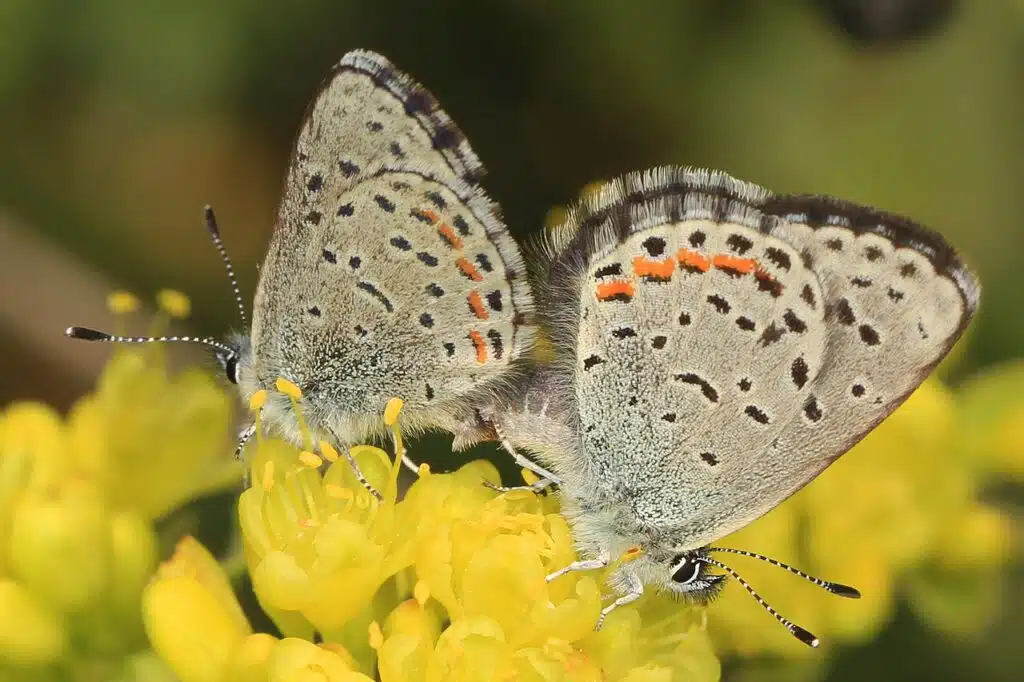
Dotted Blue butterflies (Euphilotes enoptes) come in either blue or white coloring.
These butterflies have black dots and orange bands across the wings. Black overlays are also specific both to the white and to the blue variations of the species.
Dotted Blue butterflies only live in California. They are present all across the state in large numbers.
A good population of butterflies is seen around the Los Angeles area. These butterflies also live around San Jose and San Francisco.
Dotted Blue butterflies also live in the woodlands around the Six Rivers National Forest.
43. Ancilla Blue
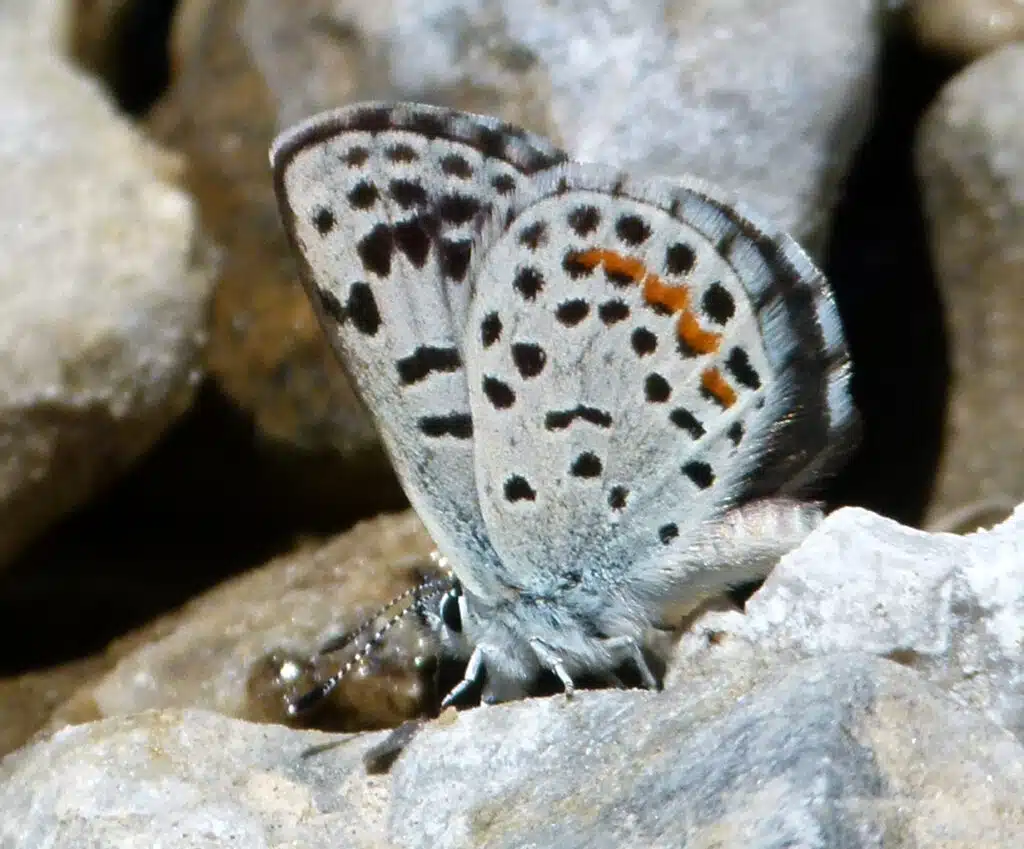
Ancilla Blue (Euphilotes ancilla) is one of the multiple white butterflies with white dots and orange coloring on the wings in the US.
This native species
has multiple irregular-shaped black marks across the wings alongside black dots.
White and black coloring is also specific to its wings.
Unlike the Dotted Blue, this species also lives outside California. It lives in Washington and Utah among other states in the Western US territories.
You can see Ancilla Blue butterflies in large colonies across these states. It likes to be active around wild buckwheat and flowers that live on rocky hillsides.
The larvae of the Ancilla Blue butterflies are only seen on wild buckwheat.
44. Olympia Marble
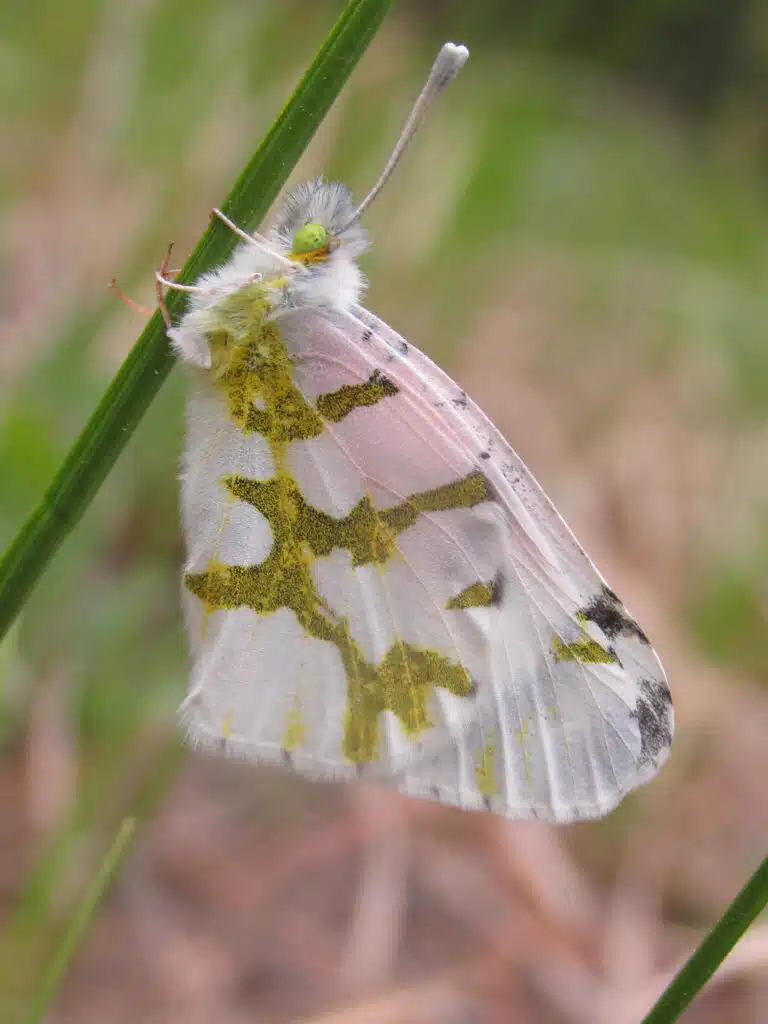
Olympia Marble white butterflies (Euchloe olympia) are one of the native white species that’s found in most US states except those in the West.
You can identify this species by its white color and black or gray patterns on the dorsum.
Butterflies of this genus also have smaller black marks on the wings.
The ventral side of the species is also white but it features green vein-like marks which are believed to be more similar to the plants it visits for camouflage.
The wingspan of the species varies considerably but it’s never longer than 2 inches.
Adult butterflies and caterpillars feed on different types of rock cresses. These grow in full sun and feed the species from April onwards until August or September in the North or until July in the South.
Further Reading: